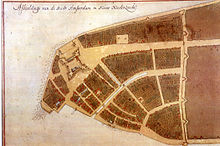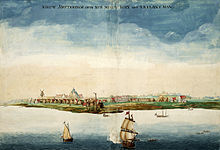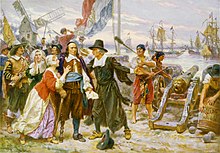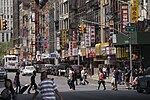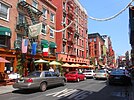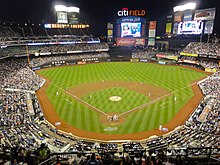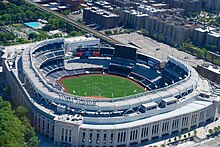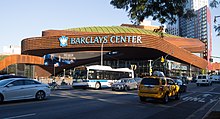New York City
New York | |
|---|---|
| Nicknames: | |
| Coordinates: 40°42′46″N 74°00′22″W / 40.71278°N 74.00611°W[2] | |
| Country | United States |
| State | New York |
| Region | Mid-Atlantic |
| Constituent counties (boroughs) | Bronx (The Bronx) Kings (Brooklyn) New York (Manhattan) Queens (Queens) Richmond (Staten Island) |
| Settled | 1624 |
| Consolidated | 1898 |
| Named for | James, Duke of York |
| Government | |
| • Type | Strong mayor–council |
| • Body | New York City Council |
| • Mayor | Eric Adams (D) |
| Area | |
| • Total | 472.43 sq mi (1,223.59 km2) |
| • Land | 300.46 sq mi (778.18 km2) |
| • Water | 171.97 sq mi (445.41 km2) |
| Highest elevation | 401 ft (122 m) |
| Lowest elevation | 0 ft (0 m) |
| Population | |
| • Total | 8,804,190 |
| • Estimate (July 2022)[5] | 8,335,897 |
| • Rank | 1st in the United States 1st in New York State |
| • Density | 29,302.66/sq mi (11,313.81/km2) |
| • Urban | 19,426,449 |
| • Urban density | 5,980.8/sq mi (2,309.2/km2) |
| • Metro | 20,140,470 |
| Demonym | New Yorker |
| GDP | |
| • New York City | $1.053 trillion (2022)[9] (1st) |
| • New York (CSA) | $2.109 trillion (2022) (1st)[9] |
| Time zone | UTC–05:00 (EST) |
| • Summer (DST) | UTC–04:00 (EDT) |
| ZIP Codes | 100xx–104xx, 11004–05, 111xx–114xx, 116xx |
| Area codes | 212/646/332, 718/347/929, 917 |
| FIPS code | 36-51000 |
| GNIS feature ID | 975772 |
| Largest borough by area | Queens (109 sq mi or 280 km2) |
| Largest borough by population | Brooklyn (2020 Census 2,736,074) |
| Largest borough by GDP (2022) | Manhattan ($780.966 billion)[9] |
| Website | nyc |
New York, often called New York City[b] or simply NYC, is the most populous city in the United States located at the southern tip of New York State on one of the world's largest natural harbors. The city comprises five boroughs, each of which is coextensive with a respective county. It is a global city and a cultural, financial, high-tech,[11] entertainment, and media center with a significant influence on commerce, health care, scientific output, life sciences,[12][13] research, technology, education, politics, tourism, dining, art, fashion, and sports. Home to the headquarters of the United Nations, New York is an important center for international diplomacy,[14][15] and it is sometimes described as the world's most important city[16] and the capital of the world.[17][18]
New York City traces its origins to Fort Amsterdam and a trading post founded on the southern tip of Manhattan Island by Dutch colonists in approximately 1624. The settlement was named New Amsterdam (Dutch: Nieuw Amsterdam) in 1626 and was chartered as a city in 1653. The city came under British control in 1664 and was renamed New York after King Charles II granted the lands to his brother, the Duke of York.[19] The city was temporarily regained by the Dutch in July 1673 and was renamed New Orange; the city has been named New York since November 1674. New York City was the capital of the United States from 1785 until 1790.[20] The modern city was formed by the 1898 consolidation of its five boroughs: Manhattan, Brooklyn, Queens, The Bronx, and Staten Island, and has been the largest U.S. city ever since.
With a census-estimated population of 8,335,897 distributed over 300.46 square miles (778.2 km2) in 2022,[4] the city is the most densely populated major city in the United States. NYC has more than double the population of Los Angeles, the nation's second-most populous city. New York is the geographical and demographic center of both the Northeast megalopolis and the New York metropolitan area, the largest metropolitan area in the U.S. by both population and urban area. With over 20.1 million people in its metropolitan statistical area and 23.5 million in its combined statistical area as of 2020, New York City is one of the world's most populous megacities.[21] The city and its metropolitan area are the premier gateway for legal immigration to the United States. As many as 800 languages are spoken in New York,[22] making it the most linguistically diverse city in the world. The city is home to more than 3.2 million residents born outside the U.S., the largest foreign-born population of any city in the world as of 2016.[23]
Anchored by Wall Street in the Financial District of Lower Manhattan, New York City has been called both the world's leading financial and fintech center[24][25] and the most economically powerful city in the world,[26] and is home to the world's two largest stock exchanges by market capitalization of their listed companies: the New York Stock Exchange and Nasdaq.[27][28] As of 2021[update], the New York metropolitan area is the second-largest metropolitan economy in the world with a gross metropolitan product of almost $2.0 trillion. If the New York metropolitan area were its own country, it would have the tenth-largest economy in the world. New York City is an established safe haven for global investors.[29] As of 2023[update], New York City is the most expensive city in the world for expatriates to live.[30] New York City is home to the highest number of billionaires,[31][32] individuals of ultra-high net worth (greater than US$30 million),[33] and millionaires of any city in the world.[34]
Etymology
In 1664, New York was named in honor of the Duke of York (later King James II of England).[35] James's elder brother, King Charles II, appointed the Duke as proprietor of the former territory of New Netherland, including the city of New Amsterdam, when England seized it from Dutch control.[36]
History
Early history
In the pre-Columbian era, the area of present-day New York City was inhabited by Algonquians, including the Lenape. Their homeland, known as Lenapehoking, included the present-day areas of Staten Island, Manhattan, the Bronx, the western portion of Long Island (including Brooklyn and Queens), and the Lower Hudson Valley.[37]
The first documented visit into New York Harbor by a European was in 1524 by Giovanni da Verrazzano, an explorer from Florence in the service of the French crown.[38] He claimed the area for France and named it Nouvelle Angoulême (New Angoulême).[39] A Spanish expedition, led by the Portuguese captain Estêvão Gomes sailing for Emperor Charles V, arrived in New York Harbor in January 1525 and charted the mouth of the Hudson River, which he named Río de San Antonio ('Saint Anthony's River').[40]
In 1609, the English explorer Henry Hudson rediscovered New York Harbor while searching for the Northwest Passage to the Orient for the Dutch East India Company.[41] He proceeded to sail up what the Dutch would name the North River (now the Hudson River), named first by Hudson as the Mauritius after Maurice, Prince of Orange. Hudson's first mate described the harbor as "a very good Harbour for all windes" and the river as "a mile broad" and "full of fish".[42]
Hudson claimed the region for the Dutch East India Company. In 1614, the area between Cape Cod and Delaware Bay was claimed by the Netherlands and called Nieuw-Nederland ('New Netherland'). The first non–Native American inhabitant of what would eventually become New York City was Juan Rodriguez, a merchant from Santo Domingo who arrived in Manhattan during the winter of 1613–14, trapping for pelts and trading with the local population as a representative of the Dutch colonists.[43][44]
Dutch rule
A permanent European presence near New York Harbor was established in 1624, making New York the 12th-oldest continuously occupied European-established settlement in the continental United States, with the founding of a Dutch fur trading settlement on Governors Island. In 1625, construction was started on a citadel and Fort Amsterdam, later called Nieuw Amsterdam (New Amsterdam), on present-day Manhattan Island.[45][46]
The colony of New Amsterdam was centered on what would ultimately become Lower Manhattan. Its area extended from the southern tip of Manhattan to modern-day Wall Street, where a 12-foot (3.7 m) wooden stockade was built in 1653 to protect against Native American and British raids.[47] In 1626, the Dutch colonial Director-General Peter Minuit, acting as charged by the Dutch West India Company, purchased the island of Manhattan from the Canarsie, a small Lenape band,[48] for "the value of 60 guilders"[49] (about $900 in 2018).[50] A frequently told but disproved legend claims that Manhattan was purchased for $24 worth of glass beads.[51][52]
Following the purchase, New Amsterdam grew slowly.[19] To attract settlers, the Dutch instituted the patroon system in 1628, whereby wealthy Dutchmen (patroons, or patrons) who brought 50 colonists to New Netherland would be awarded swaths of land, along with local political autonomy and rights to participate in the lucrative fur trade. This program had little success.[53]
Since 1621, the Dutch West India Company had operated as a monopoly in New Netherland, on authority granted by the Dutch States General. In 1639–1640, in an effort to bolster economic growth, the Dutch West India Company relinquished its monopoly over the fur trade, leading to growth in the production and trade of food, timber, tobacco, and slaves (particularly with the Dutch West Indies).[19][54]
In 1647, Peter Stuyvesant began his tenure as the last Director-General of New Netherland. During his tenure, the population of New Netherland grew from 2,000 to 8,000.[55][56] Stuyvesant has been credited with improving law and order in the colony; however, he earned a reputation as a despotic leader. He instituted regulations on liquor sales, attempted to assert control over the Dutch Reformed Church, and blocked other religious groups (including Quakers, Jews, and Lutherans) from establishing houses of worship.[57] The Dutch West India Company would eventually attempt to ease tensions between Stuyvesant and residents of New Amsterdam.[58]
English rule
In 1664, unable to summon any significant resistance, Stuyvesant surrendered New Amsterdam to English troops, led by Colonel Richard Nicolls, without bloodshed.[57][58] The terms of the surrender permitted Dutch residents to remain in the colony and allowed for religious freedom.[59]
In 1667, during negotiations leading to the Treaty of Breda after the Second Anglo-Dutch War, the victorious Dutch decided to keep the nascent plantation colony of what is now Suriname on the northern South American coast, which they had gained from the English;[60] and in return, the English kept New Amsterdam. The fledgling settlement was promptly renamed "New York" after the Duke of York (the future King James II and VII).[61] After the founding, the duke gave part of the colony to proprietors George Carteret and John Berkeley. Fort Orange, 150 miles (240 km) north on the Hudson River, was renamed Albany after James's Scottish title.[62]
On August 24, 1673, during the Third Anglo-Dutch War, Anthony Colve of the Dutch navy seized New York from the English at the behest of Cornelis Evertsen the Youngest and rechristened it "New Orange" after William III, the Prince of Orange.[63] The Dutch would soon return the island to England under the Treaty of Westminster of November 1674.[64][65]
Several intertribal wars among the Native Americans and some epidemics brought on by contact with the Europeans caused sizeable population losses for the Lenape between the years 1660 and 1670.[66] By 1700, the Lenape population had diminished to 200.[67] New York experienced several yellow fever epidemics in the 18th century, losing ten percent of its population in 1702 alone.[68][69]
In the early 18th century, New York grew in importance as a trading port while as a part of the colony of New York.[70] It became a center of slavery, with 42% of households enslaving Africans by 1730.[71] Most cases were that of domestic slavery; others were hired out to work at labor. Slavery became integrally tied to New York's economy through the labor of slaves throughout the port, and the banking and shipping industries trading with the American South. During construction in Foley Square in the 1990s, the African Burying Ground was discovered; the cemetery included 10,000 to 20,000 of graves of colonial-era Africans, some enslaved and some free.[72]
The 1735 trial and acquittal in Manhattan of John Peter Zenger, who had been accused of seditious libel after criticizing colonial governor William Cosby, helped to establish freedom of the press in North America.[73] In 1754, Columbia University was founded under charter by King George II as King's College in Lower Manhattan.[74]
American Revolution

The Stamp Act Congress met in New York in October 1765, as the Sons of Liberty organization emerged in the city and skirmished over the next ten years with British troops stationed there.[75] The Battle of Long Island, the largest battle of the American Revolutionary War, was fought in August 1776 within the modern-day borough of Brooklyn.[76] A British rout of the Continental Army at the Battle of Fort Washington in November 1776 eliminated the last American stronghold in Manhattan, forcing George Washington and his forces in retreat across the Hudson River to New Jersey, pursued by British forces.[77][78]
After the battle, in which the Americans were defeated, the British made the city their military and political base of operations in North America.[79] The city was a haven for Loyalist refugees and escaped slaves who joined the British lines for freedom newly promised by the Crown, with as many as 10,000 escaped slaves crowded into the city during the British occupation, which had become the largest such community on the continent.[80][81] When the British forces evacuated New York at the close of the war in 1783, they transported thousands of freedmen for resettlement in Nova Scotia, England, and the Caribbean.[82]
The attempt at a peaceful solution to the war took place at the Conference House on Staten Island between American delegates, including Benjamin Franklin, and British general Lord Howe on September 11, 1776.[83] Shortly after the British occupation began, the Great Fire of New York occurred, a large conflagration on the West Side of Lower Manhattan, which destroyed nearly 500 buildings, about a quarter of the structures in the city, including Trinity Church.[84][85]
Post-revolutionary period and early 19th century
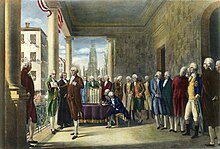
In January 1785, the assembly of the Congress of the Confederation made New York City the national capital, shortly after the war.[86] New York was the last capital of the U.S. under the Articles of Confederation and the first capital under the Constitution of the United States.[87] As the U.S. capital, New York City hosted several events of national scope in 1789—the first President of the United States, George Washington, was inaugurated; the first United States Congress and the Supreme Court of the United States each assembled for the first time; and the United States Bill of Rights was drafted, all at Federal Hall on Wall Street.[87]
In 1790, for the first time, New York City, surpassed Philadelphia as the nation's largest city. At the end of 1790, the national capital was moved to Philadelphia.[88][89]
Over the nineteenth century, New York City's population grew from 60,000 to 3.43 million.[90] Under New York State's abolition act of 1799, children of slave mothers were to be eventually liberated but to be held in indentured servitude until their mid-to-late twenties.[91][92] Together with slaves freed by their masters after the Revolutionary War and escaped slaves, a significant free-Black population gradually developed in Manhattan. Under such influential United States founders as Alexander Hamilton and John Jay, the New York Manumission Society worked for abolition and established the African Free School to educate Black children.[93] It was not until 1827 that slavery was completely abolished in the state, and free Blacks struggled afterward with discrimination. New York interracial abolitionist activism continued; among its leaders were graduates of the African Free School.[importance?] New York city's population jumped from 123,706 in 1820 to 312,710 by 1840, 16,000 of whom were Black.[94][95]
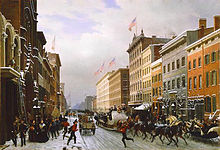
In the 19th century, the city was transformed by both commercial and residential development relating to its status as a national and international trading center, as well as by European immigration, respectively.[97] The city adopted the Commissioners' Plan of 1811, which expanded the city street grid to encompass almost all of Manhattan. The 1825 completion of the Erie Canal through central New York connected the Atlantic port to the agricultural markets and commodities of the North American interior via the Hudson River and the Great Lakes.[98] Local politics became dominated by Tammany Hall, a political machine supported by Irish and German immigrants.[99]
Several prominent American literary figures lived in New York during the 1830s and 1840s, including William Cullen Bryant, Washington Irving, Herman Melville, Rufus Wilmot Griswold, John Keese, Nathaniel Parker Willis, and Edgar Allan Poe. Public-minded members of the contemporaneous business elite lobbied for the establishment of Central Park, which in 1857 became the first landscaped park in an American city.[100] and one of the most filmed and visited locations in the world, with 40 million visitors in 2013.[101]
The Great Irish Famine brought a large influx of Irish immigrants, of whom more than 200,000 were living in New York by 1860, representing upward of one-quarter of the city's population.[102] There was also extensive immigration from the German provinces, where revolutions had disrupted societies, and Germans comprised another 25% of New York's population by 1860.[103][104]
American Civil War

Democratic Party candidates were consistently elected to local office, increasing the city's ties to the South and its dominant party. In 1861, Mayor Fernando Wood called on the aldermen to declare independence from Albany and the United States after the South seceded, but his proposal was not acted on.[93] Anger at new military conscription laws during the American Civil War (1861–1865), which spared wealthier men who could afford to hire a substitute, led to the Draft Riots of 1863, whose most visible participants were ethnic Irish working class.[93]
The draft riots deteriorated into attacks on New York's elite, followed by attacks on Black New Yorkers and their property after fierce competition for a decade between Irish immigrants and Black people for work. Rioters burned the Colored Orphan Asylum to the ground, with more than 200 children escaping harm due to efforts of the New York Police Department, which was mainly made up of Irish immigrants.[103]
At least 120 people were killed.[105] Eleven Black men were lynched over five days, and the riots forced hundreds of Blacks to flee. The Black population in Manhattan fell below 10,000 by 1865. The White working class had established dominance.[103][105] Violence by longshoremen against Black men was especially fierce in the docks area.[103] It was one of the worst incidents of civil unrest in American history.[106]
Late 19th and early 20th century

In 1886, the Statue of Liberty, a gift from France, was dedicated in New York Harbor. The statue welcomed 14 million immigrants as they came to the U.S. via Ellis Island by ship in the late 19th and early 20th centuries, and is a symbol of the United States and American ideals of liberty and peace.[107][108]
In 1898, the City of New York was formed with the consolidation of Brooklyn (until then a separate city), the County of New York (which then included parts of the Bronx), the County of Richmond, and the western portion of the County of Queens.[109] The opening of the subway in 1904, first built as separate private systems, helped bind the new city together.[110] Throughout the first half of the 20th century, the city became a world center for industry, commerce, and communication.[111]
In 1904, the steamship General Slocum caught fire in the East River, killing 1,021 people on board.[112] In 1911, the Triangle Shirtwaist Factory fire, the city's worst industrial disaster, killed 146 garment workers and spurred the growth of the International Ladies' Garment Workers' Union and major improvements in factory safety standards.[113]
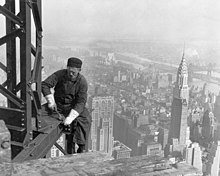
New York's non-White population was 36,620 in 1890.[114] New York City was a prime destination in the early twentieth century for African Americans during the Great Migration from the American South, and by 1916, New York City had become home to the largest urban African diaspora in North America.[115] The Harlem Renaissance of literary and cultural life flourished during the era of Prohibition.[116] The larger economic boom generated construction of skyscrapers competing in height and creating an identifiable skyline.
New York City became the most populous urbanized area in the world in the early 1920s, overtaking London. The metropolitan area surpassed the 10 million mark in the early 1930s, becoming the first megacity in human history.[117] The Great Depression saw the election of reformer Fiorello La Guardia as mayor and the fall of Tammany Hall after eighty years of political dominance.[118]
Returning World War II veterans created a post-war economic boom and the development of large housing tracts in eastern Queens and Nassau County. New York emerged from the war unscathed as the leading city of the world, with Wall Street leading America's place as the world's dominant economic power. The United Nations headquarters was completed in 1952, solidifying New York's global geopolitical influence, and the rise of abstract expressionism in the city precipitated New York's displacement of Paris as the center of the art world.[119]
Late 20th and early 21st centuries

In 1969, the Stonewall riots were a series of spontaneous, violent protests by members of the gay community against a police raid that took place in the early morning of June 28, 1969, at the Stonewall Inn in the Greenwich Village neighborhood of Lower Manhattan.[123] They are widely considered to be the single most important event leading to the gay liberation movement[120][124][125][126] and the modern fight for LGBT rights.[127][128] Wayne R. Dynes, author of the Encyclopedia of Homosexuality, wrote that drag queens were the only "transgender folks around" during the June 1969 Stonewall riots. The transgender community in New York City played a significant role in fighting for LGBT equality during the period of the Stonewall riots and thereafter.[129] In the 1970s, job losses due to industrial restructuring caused New York City to suffer from economic problems and rising crime rates.[130] While a resurgence in the financial industry greatly improved the city's economic health in the 1980s, New York's crime rate continued to increase through that decade and into the beginning of the 1990s.[131] By the mid 1990s, crime rates started to drop dramatically due to revised police strategies, improving economic opportunities, gentrification, and new residents, both American transplants and new immigrants from Asia and Latin America.
New York City's population reached all-time highs in the 2000, 2010, and 2020 US censuses. Important new sectors, such as Silicon Alley, emerged in the city's economy.[132]
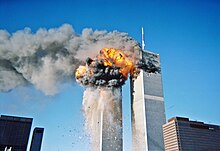
The advent of Y2K was celebrated with fanfare in Times Square.[133] New York City suffered the bulk of the economic damage and largest loss of human life in the aftermath of the September 11, 2001, attacks.[134] Two of the four airliners hijacked that day were flown into the twin towers of the World Trade Center, destroying the towers and killing 2,192 civilians, 343 firefighters, and 71 law enforcement officers. The North Tower became, and remains, the tallest building to ever be destroyed.[135]
The area was rebuilt with a new World Trade Center, the National September 11 Memorial and Museum, and other new buildings and infrastructure,[136] including the World Trade Center Transportation Hub, the city's third-largest hub.[137] The new One World Trade Center is the tallest skyscraper in the Western Hemisphere[138] and the seventh-tallest building in the world by pinnacle height, with its spire reaching a symbolic 1,776 feet (541.3 m) in reference to the year of U.S. independence.[139][140][141]
The Occupy Wall Street protests in Zuccotti Park in the Financial District of Lower Manhattan began on September 17, 2011, receiving global attention and popularizing the Occupy movement against social and economic inequality worldwide.[142]
New York City was heavily affected by Hurricane Sandy in late October 2012. Sandy's impacts included the flooding of the New York City Subway system, of many suburban communities, and of all road tunnels entering Manhattan except the Lincoln Tunnel. The New York Stock Exchange closed for two consecutive days. At least 43 people died in New York City as a result of Sandy, and the economic losses in New York City were estimated to be roughly $19 billion. The disaster spawned long-term efforts towards infrastructural projects to counter climate change and rising seas.[143]
In March 2020, the first case of COVID-19 in the city was confirmed in Manhattan.[144] The city rapidly replaced Wuhan, China to become the global epicenter of the pandemic during the early phase, before the infection became widespread across the world and the rest of the nation. As of March 2021, New York City had recorded over 30,000 deaths from COVID-19-related complications.
Geography
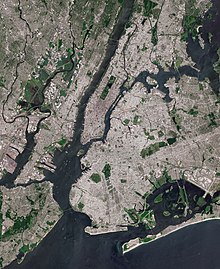
New York City is situated in the northeastern United States, in southeastern New York State, approximately halfway between Washington, D.C. and Boston. Its location at the mouth of the Hudson River, which feeds into a naturally sheltered harbor and then into the Atlantic Ocean, has helped the city grow in significance as a trading port. Most of the city is built on the three islands of Long Island, Manhattan, and Staten Island.
During the Wisconsin glaciation, 75,000 to 11,000 years ago, the New York City area was situated at the edge of a large ice sheet.[145] The erosive forward movement of the ice (and its subsequent retreat) contributed to the separation of what is now Long Island and Staten Island. That action left bedrock at a relatively shallow depth, providing a solid foundation for most of Manhattan's skyscrapers.[146]
The Hudson River flows through the Hudson Valley into New York Bay. Between New York City and Troy, New York, the river is an estuary.[147] The Hudson River separates the city from the U.S. state of New Jersey. The East River—a tidal strait—flows from Long Island Sound and separates the Bronx and Manhattan from Long Island. The Harlem River, another tidal strait between the East and Hudson rivers, separates most of Manhattan from the Bronx. The Bronx River, which flows through the Bronx and Westchester County, is the only entirely freshwater river in the city.[148][importance?]
The city's land has been altered substantially by human intervention, with considerable land reclamation along the waterfronts since Dutch colonial times; reclamation is most prominent in Lower Manhattan, with developments such as Battery Park City in the 1970s and 1980s.[149] Some of the natural relief in topography has been evened out, especially in Manhattan.[150]
The city's total area is 468.484 square miles (1,213.37 km2). 302.643 sq mi (783.84 km2) of the city is land and 165.841 sq mi (429.53 km2) of is water.[151][152] The highest point in the city is Todt Hill on Staten Island, which, at 409.8 feet (124.9 m) above sea level, is the highest point on the eastern seaboard south of Maine.[153] The summit of the ridge is mostly covered in woodlands as part of the Staten Island Greenbelt.[154]
Boroughs

New York City is sometimes referred to collectively as the Five Boroughs.[155] Each borough is coextensive with a respective county of New York State, making New York City one of the U.S. municipalities in multiple counties.
Manhattan (New York County) is the geographically smallest and most densely populated borough. It is home to Central Park and most of the city's skyscrapers, and is sometimes locally known as The City.[156] Manhattan's population density of 70,450.8 inhabitants per square mile (27,201.2/km2) in 2022 makes it the highest of any county in the United States and higher than the density of any individual American city.[157] Manhattan is the cultural, administrative, and financial center of New York City and contains the headquarters of many major multinational corporations, the United Nations headquarters, Wall Street, and a number of important universities. The borough is often described as the financial and cultural center of the world.[158][159]
Brooklyn (Kings County), on the western tip of Long Island, is the city's most populous borough. Brooklyn is known for its cultural, social, and ethnic diversity, an independent art scene, distinct neighborhoods, and a distinctive architectural heritage. Downtown Brooklyn is the largest central core neighborhood in the Outer Boroughs. The borough has a long beachfront shoreline including Coney Island, established in the 1870s as one of the earliest amusement grounds in the U.S.[160] Marine Park and Prospect Park are the two largest parks in Brooklyn.[161] Since 2010, Brooklyn has evolved into a thriving hub of entrepreneurship and high technology startup firms,[162][163] and of postmodern art and design.[163][164] Brooklyn is also home to Fort Hamilton, the U.S. military's only active duty installation within New York City,[165] aside from Coast Guard operations. The facility was established in 1825 on the site of a battery used during the American Revolution, and it is one of America's longest serving military forts.[166]
Queens (Queens County), on Long Island north and east of Brooklyn, is geographically the largest borough, the most ethnically diverse county in the United States,[167] and the most ethnically diverse urban area in the world.[168][169] Queens is the site of the Citi Field baseball stadium, home of the New York Mets, and hosts the annual U.S. Open tennis tournament at Flushing Meadows–Corona Park. Additionally, two of the three busiest airports serving the New York metropolitan area, John F. Kennedy International Airport and LaGuardia Airport, are in Queens.
The Bronx (Bronx County) is both New York City's northernmost borough, and the only one that is mostly on the mainland. It is the location of Yankee Stadium, the baseball park of the New York Yankees, and home to the largest cooperatively-owned housing complex in the United States, Co-op City.[170] It is home to the Bronx Zoo, the world's largest metropolitan zoo,[171] which spans 265 acres (1.07 km2) and houses more than 6,000 animals.[172] The Bronx is the birthplace of hip hop music and its associated culture.[173] Pelham Bay Park is the largest park in New York City, at 2,772 acres (1,122 ha).[174]
Staten Island (Richmond County) is the most suburban in character of the five boroughs. It is connected to Brooklyn by the Verrazzano-Narrows Bridge, and to Manhattan by way of the free Staten Island Ferry. In central Staten Island, the Staten Island Greenbelt spans approximately 2,500 acres (10 km2), including 28 miles (45 km) of walking trails and one of the last undisturbed forests in the city.[175] Designated in 1984 to protect the island's natural lands, the Greenbelt comprises seven city parks.
Climate
| New York City | ||||||||||||||||||||||||||||||||||||||||||||||||||||||||||||
|---|---|---|---|---|---|---|---|---|---|---|---|---|---|---|---|---|---|---|---|---|---|---|---|---|---|---|---|---|---|---|---|---|---|---|---|---|---|---|---|---|---|---|---|---|---|---|---|---|---|---|---|---|---|---|---|---|---|---|---|---|
| Climate chart (explanation) | ||||||||||||||||||||||||||||||||||||||||||||||||||||||||||||
| ||||||||||||||||||||||||||||||||||||||||||||||||||||||||||||
| ||||||||||||||||||||||||||||||||||||||||||||||||||||||||||||
Under the Köppen climate classification, New York City has a humid subtropical climate (Cfa), and is the northernmost major city on the North American continent with this categorization. The suburbs to the immediate north and west are in the transitional zone between humid subtropical and humid continental climates (Dfa).[176][177] New York averages over 2,500 hours of sunshine annually.[178]
Winters are chilly and damp, and prevailing wind patterns that blow sea breezes offshore temper the moderating effects of the Atlantic Ocean; yet the Atlantic and the partial shielding from colder air by the Appalachian Mountains keep the city warmer in the winter than inland North American cities at similar or lesser latitudes.[179] The daily mean temperature in January, the area's coldest month, is 33.3 °F (0.7 °C).[180] Temperatures usually drop to 10 °F (−12 °C) several times per winter,[181] yet can also reach 60 °F (16 °C) for several days even in the coldest winter month. Spring and autumn are unpredictable and can range from cool to warm, although they are usually mild with low humidity. Summers are typically hot and humid, with a daily mean temperature of 77.5 °F (25.3 °C) in July.[180]
Nighttime temperatures are 9.5 °F (5.3 °C) degrees higher for the average city resident due to the urban heat island effect, caused by paved streets and tall buildings.[182] Daytime temperatures exceed 90 °F (32 °C) on average of 17 days each summer and in some years exceed 100 °F (38 °C), although this is a rare occurrence, last noted on July 18, 2012.[183][184][185][186] Similarly, readings of 0 °F (−18 °C) are extremely rare, last occurring on February 14, 2016.[187] Extreme temperatures have ranged from 106 °F (41 °C), recorded on July 9, 1936, down to −15 °F (−26 °C) on February 9, 1934;[180] the coldest recorded wind chill was −37 °F (−38 °C) on the same day as the all-time record low.[188] The record cold daily maximum was 2 °F (−17 °C) on December 30, 1917, while, conversely, the record warm daily minimum was 87 °F (31 °C), on July 2, 1903.[183] The average water temperature of the nearby Atlantic Ocean ranges from 39.7 °F (4.3 °C) in February to 74.1 °F (23.4 °C) in August.[189]
The city receives 49.5 inches (1,260 mm) of precipitation annually, which is relatively evenly spread throughout the year. Average winter snowfall between 1991 and 2020 was 29.8 inches (76 cm); this varies considerably between years. Hurricanes and tropical storms are rare in the New York area.[190] Hurricane Sandy brought a destructive storm surge to New York City on the evening of October 29, 2012, flooding numerous streets, tunnels, and subway lines in Lower Manhattan and other areas of the city and cutting off electricity in many parts of the city and its suburbs.[191] The storm and its profound impacts have prompted the discussion of constructing seawalls and other coastal barriers around the shorelines of the city and the metropolitan area to minimize the risk of destructive consequences from another such event in the future.[143]
Parks


The city of New York has a complex park system, with various lands operated by the National Park Service, the New York State Office of Parks, Recreation and Historic Preservation, and the New York City Department of Parks and Recreation. In its 2018 ParkScore ranking, the Trust for Public Land reported that the park system in New York City was the ninth-best park system among the fifty most populous U.S. cities.[192]
Gateway National Recreation Area contains over 26,000 acres (110 km2), most of it in New York City.[193] In Brooklyn and Queens, the park contains over 9,000 acres (36 km2) of salt marsh, wetlands, islands, and water, including most of Jamaica Bay and the Jamaica Bay Wildlife Refuge. Also in Queens, the park includes a significant portion of the western Rockaway Peninsula, most notably Jacob Riis Park and Fort Tilden. In Staten Island, it includes Fort Wadsworth, with historic pre-Civil War era Battery Weed and Fort Tompkins, and Great Kills Park.
The Statue of Liberty National Monument and Ellis Island Immigration Museum are managed by the National Park Service and are in both New York and New Jersey. They are joined in the harbor by Governors Island National Monument. Historic sites under federal management on Manhattan Island include Stonewall National Monument; Castle Clinton National Monument; Federal Hall National Memorial; Theodore Roosevelt Birthplace National Historic Site; General Grant National Memorial (Grant's Tomb); African Burial Ground National Monument; and Hamilton Grange National Memorial. Hundreds of properties are listed on the National Register of Historic Places or as a National Historic Landmark.
There are seven state parks within the confines of New York City. They include: The Clay Pit Ponds State Park Preserve, a natural area that includes extensive riding trails; the Riverbank State Park, a 28-acre (11 ha) facility;[194] and the Marsha P. Johnson State Park, a state park in Brooklyn and Manhattan that borders the East River renamed in honor of Marsha P. Johnson[195]
New York City has over 28,000 acres (110 km2) of municipal parkland and 14 miles (23 km) of public beaches.[196] The largest municipal park in the city is Pelham Bay Park in the Bronx, with 2,772 acres (1,122 ha),[174][197] and the most visited urban park is the Central Park, and one of the most filmed and visited locations in the world, with 40 million visitors in 2013.[101]
Environment
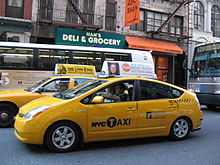
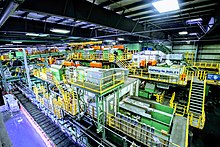
Environmental issues in New York City are affected by the city's size, density, abundant public transportation infrastructure, and its location at the mouth of the Hudson River. For example, it is one of the country's biggest sources of pollution and has the lowest per-capita greenhouse gas emissions rate and electricity usage. Governors Island is planned to host a US$1 billion research and education center to make New York City the global leader in addressing the climate crisis.[201]
As an oceanic port city, New York City is vulnerable to the long-term manifestations of global warming and rising seas. Climate change has spawned the development of a significant climate resiliency and environmental sustainability economy in the city. New York City has focused on reducing its environmental impact and carbon footprint.[202] Mass transit use is the highest in the United States. Also, by 2010, the city had 3,715 hybrid taxis and other clean diesel vehicles, representing around 28% of New York's taxi fleet in service, the most of any city in North America.[203]
New York's high rate of public transit use, more than 200,000 daily cyclists as of 2014[update],[204] and many pedestrian commuters make it the most energy-efficient major city in the United States.[205] Walk and bicycle modes of travel account for 21% of all modes for trips in the city; nationally the rate for metro regions is about 8%.[206] In both its 2011 and 2015 rankings, Walk Score named New York City the most walkable large city in the United States,[207][208][209] and in 2018, Stacker ranked New York the most walkable U.S. city.[210] Citibank sponsored public bicycles for the city's bike-share project, which became known as Citi Bike, in 2013.[211] New York City's numerical "in-season cycling indicator" of bicycling in the city had hit an all-time high of 437 when measured in 2014.[212]
The New York City drinking water supply is extracted from the protected Catskill Mountains watershed.[213] As a result of the watershed's integrity and undisturbed natural water filtration system, New York is one of only four major cities in the United States the majority of whose drinking water is pure enough not to require purification through water treatment plants.[214] The city's municipal water system is the largest in the United States, moving more than 1 billion U.S. gallons (3.8 billion liters) of water daily from a watershed covering 1,900 square miles (4,900 km2)[215][216]
According to the 2016 World Health Organization Global Urban Ambient Air Pollution Database,[217] the annual average concentration in New York City's air of particulate matter measuring 2.5 micrometers or less (PM2.5) was 7.0 micrograms per cubic meter, or 3.0 micrograms within the recommended limit of the WHO Air Quality Guidelines for the annual mean PM2.5.[218] The New York City Department of Health and Mental Hygiene, in partnership with Queens College, conducts the New York Community Air Survey to measure pollutants at about 150 locations.[219]
Demographics
| Year | Pop. | ±% |
|---|---|---|
| 1698 | 4,937 | — |
| 1712 | 5,840 | +18.3% |
| 1723 | 7,248 | +24.1% |
| 1737 | 10,664 | +47.1% |
| 1746 | 11,717 | +9.9% |
| 1756 | 13,046 | +11.3% |
| 1771 | 21,863 | +67.6% |
| 1790 | 33,131 | +51.5% |
| 1800 | 60,515 | +82.7% |
| 1810 | 96,373 | +59.3% |
| 1820 | 123,706 | +28.4% |
| 1830 | 202,589 | +63.8% |
| 1840 | 312,710 | +54.4% |
| 1850 | 515,547 | +64.9% |
| 1860 | 813,669 | +57.8% |
| 1870 | 942,292 | +15.8% |
| 1880 | 1,206,299 | +28.0% |
| 1890 | 1,515,301 | +25.6% |
| 1900 | 3,437,202 | +126.8% |
| 1910 | 4,766,883 | +38.7% |
| 1920 | 5,620,048 | +17.9% |
| 1930 | 6,930,446 | +23.3% |
| 1940 | 7,454,995 | +7.6% |
| 1950 | 7,891,957 | +5.9% |
| 1960 | 7,781,984 | −1.4% |
| 1970 | 7,894,862 | +1.5% |
| 1980 | 7,071,639 | −10.4% |
| 1990 | 7,322,564 | +3.5% |
| 2000 | 8,008,288 | +9.4% |
| 2010 | 8,175,133 | +2.1% |
| 2020 | 8,804,190 | +7.7% |
| 2022 est. | 8,335,897 | −5.3% |
| [c] | ||
New York City is the most populous city in the United States,[225] with 8,804,190 residents incorporating more immigration into the city than outmigration since the 2010 United States census.[223][226][227] More than twice as many people live in New York City as compared to Los Angeles, the second-most populous U.S. city.[228]
Between 2010 and 2020, New York City gained 629,000 residents, more than any other U.S. city, and a greater amount than the total sum of the gains over the same decade of the next four largest U.S. cities (Los Angeles, Chicago, Houston, and Phoenix) combined.[229][230] The city's population density of 27,744.1 inhabitants per square mile (10,712.1/km2) makes it the densest of any American municipality with a population above 100,000.[157] Manhattan's population density is 70,450.8 inhabitants per square mile (27,201.2/km2), highest of any county in the United States.[157]
New York City comprises about 44% of the state's population,[231] and about 39% of the population of the New York metropolitan area.[232] The majority of New York City residents in 2020 (5,141,538, or 58.4%) were living on Long Island, in Brooklyn, or in Queens.[233] As many as 800 languages are spoken in New York,[22][234][235][236] and the New York City metropolitan statistical area has the largest foreign-born population of any metropolitan region in the world. The New York region continues to be by far the leading metropolitan gateway for legal immigrants admitted into the United States, substantially exceeding the combined totals of Los Angeles and Miami.[237]
Race and ethnicity
The city's population in 2020 was 30.9% White (non-Hispanic), 28.7% Hispanic or Latino, 20.2% Black or African American (non-Hispanic), 15.6% Asian, and 0.2% Native American (non-Hispanic). A total of 3.4% of the non-Hispanic population identified with more than one race.[238]
As of 2013[update], approximately 36% of the city's population is foreign born,[239] and more than half of all children are born to mothers who are immigrants. Throughout its history, New York has been a major port of entry for immigrants into the United States.[240][241] No single country or region of origin dominates.[240] The ten largest sources of foreign-born individuals in the city as of 2011[update] were the Dominican Republic, China, Mexico, Guyana, Jamaica, Ecuador, Haiti, India, Russia, and Trinidad and Tobago,[242] Queens has the largest Asian American and Andean populations in the United States, and is also the most ethnically and linguistically diverse urban area in the world.[243][169]
The metropolitan area has the largest Asian Indian population in the Western Hemisphere; the largest Russian American,[244] Italian American, and African American populations; the largest Dominican American, Puerto Rican American, and South American[244] and second-largest overall Hispanic population in the United States, numbering 4.8 million.[245] Venezuela, Ecuador, Colombia, Guyana, Peru, and Brazil, are the top source countries from South America for immigrants to the New York City region; the Dominican Republic, Jamaica, Haiti, and Trinidad and Tobago in the Caribbean; Nigeria, Egypt, Ghana, Tanzania, Kenya, and South Africa from Africa; and El Salvador, Honduras, and Guatemala in Central America.[246]
New York contains the highest total Asian population of any U.S. city proper.[247] Asian Americans in New York City, according to the 2010 census, number more than one million, greater than the combined totals of San Francisco and Los Angeles.[248] New York has the largest Chinese population of any city outside Asia,[249] Manhattan's Chinatown is the highest concentration of Chinese people in the Western Hemisphere,[250] and Queens is home to the largest Tibetan population outside Asia.[251] Arab Americans number over 160,000 in New York City,[252] with the highest concentration in Brooklyn. Central Asians, primarily Uzbek Americans, are a rapidly growing segment of the city's non-Hispanic White population.[253] The metropolitan area is home to 20% of the nation's Indian Americans and at least 20 Little India enclaves, and 15% of all Korean Americans and four Koreatowns.[254]
New York City has the largest European and non-Hispanic white population of any American city, with 2.7 million in 2012.[255] The European diaspora residing in the city is very diverse and many European ethnic groups have formed enclaves.[256][257][258] New York City is home to the highest Jewish population of any city in the world, numbering 1.6 million in 2022, more than Tel Aviv and Jerusalem combined.[259] In the borough of Brooklyn, an estimated one in four residents is Jewish.[260]
LGBT culture
New York City has been described as the gay capital of the world and the central node of the LGBTQ+ sociopolitical ecosystem, and is home to one of the world's largest LGBTQ populations and the most prominent.[261] The New York metropolitan area is home to about 570,000 self-identifying gay and bisexual people, the largest in the United States.[262][263] Same-sex sexual activity between consenting adults has been legal in New York since the New York v. Onofre case in 1980 which invalidated the state's sodomy law.[264] Same-sex marriages in New York were legalized on June 24, 2011, and were authorized to take place on July 23, 2011.[265]
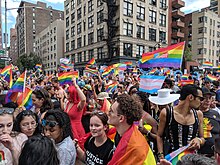
The annual New York City Pride March proceeds southward down Fifth Avenue and ends at Greenwich Village in Lower Manhattan; the parade is the largest pride parade in the world, attracting tens of thousands of participants and millions of sidewalk spectators each June.[266][267] The annual Queens Pride Parade is held in Jackson Heights and is accompanied by the ensuing Multicultural Parade.[268]
Stonewall 50 – WorldPride NYC 2019 was the largest international Pride celebration in history, commemorating the 50th anniversary of the Stonewall uprising, with 150,000 participants and five million spectators attending in Manhattan alone.[269] New York City is home to the largest transgender population in the world, estimated at more than 50,000 in 2018, concentrated in Manhattan and Queens; however, until the June 1969 Stonewall riots, this community had felt marginalized and neglected by the gay community.[268][129] Brooklyn Liberation March, the largest transgender-rights demonstration in LGBTQ history, took place on June 14, 2020, stretching from Grand Army Plaza to Fort Greene, Brooklyn, focused on supporting Black transgender lives, drawing an estimated 15,000 to 20,000 participants.[270][271]
Religion
Largely as a result of Western European missionary work and colonialism, Christianity is the largest religion (59% adherent) in New York City,[272] which is home to the highest number of churches of any city in the world.[17] Roman Catholicism is the largest Christian denomination (33%), followed by Protestantism (23%), and other Christian denominations (3%). The Roman Catholic population are primarily served by the Roman Catholic Archdiocese of New York and Diocese of Brooklyn. Eastern Catholics are divided into numerous jurisdictions throughout the city. Evangelical Protestantism is the largest branch of Protestantism in the city (9%), followed by Mainline Protestantism (8%), while the converse is usually true for other cities and metropolitan areas.[273]
Judaism, the second-largest religion practiced in New York City, with approximately 1.6 million adherents as of 2022, represents the largest Jewish community of any city in the world, greater than the combined totals of Tel Aviv and Jerusalem.[274][275] Nearly half of the city's Jews live in Brooklyn.[276][277] The ethno-religious population makes up 18.4% of the city and its religious demographic makes up 8%.[278]
Islam ranks as the third-largest religion in New York City, following Christianity and Judaism, with estimates ranging between 600,000 and 1,000,000 observers of Islam, including 10% of the city's public school children.[279] 22.3% of American Muslims live in New York City, with 1.5 million Muslims in the greater New York metropolitan area, representing the largest metropolitan Muslim population in the Western Hemisphere[280]—and the most ethnically diverse Muslim population of any city in the world.[281] Powers Street Mosque in Brooklyn is one of the oldest continuously operating mosques in the U.S., and represents the first Islamic organization in both the city and the state of New York.[282][283]
Following these three largest religious groups in New York City are Hinduism, Buddhism, Sikhism, Zoroastrianism, and others. As of 2023, 24% of Greater New Yorkers identified with no organized religious affiliation, and 4% were self-identified athiests.[284]
Education
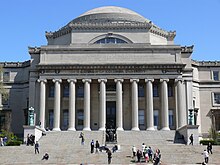
New York City has the largest educational system of any city in the world.[17] The city's educational infrastructure spans primary education, secondary education, higher education, and research. The New York City Public Schools system, managed by the New York City Department of Education, is the largest public school system in the United States, serving about 1.1 million students in approximately 1,800 separate primary and secondary schools, including charter schools, as of the 2017–2018 school year.[285] The New York City Charter School Center assists the setup of new charter schools.[286] There are approximately 900 additional privately run secular and religious schools in the city.[287]
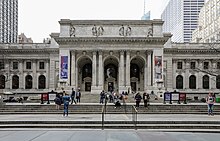
The New York Public Library (NYPL) has the largest collection of any public library system in the United States.[288] Queens is served by the Queens Borough Public Library (QPL), the nation's second-largest public library system, while the Brooklyn Public Library (BPL) serves Brooklyn.[288]
More than a million students, the highest number of any city in the United States,[289] are enrolled in New York City's more than 120 higher education institutions, with more than half a million in the City University of New York (CUNY) system alone as of 2020[update], including both degree and professional programs.[290] According to Academic Ranking of World Universities, New York City has, on average, the best higher education institutions of any global city.[291]
The public CUNY system comprising 25 institutions across all five boroughs: senior colleges, community colleges, and other graduate/professional schools. The public State University of New York (SUNY) system includes campuses in New York City, including SUNY Downstate Health Sciences University, Fashion Institute of Technology, SUNY Maritime College, and SUNY College of Optometry. New York City is home to such notable private universities as Barnard College, Columbia University, Cooper Union, Fordham University, New York University, New York Institute of Technology, Rockefeller University, and Yeshiva University; several of these universities are ranked among the top universities in the world,[292][293] while some of the world's most prestigious institutions like Princeton University and Yale University remain in the New York metropolitan area.
Much of the scientific research in the city is done in medicine and the life sciences. In 2019, the New York metropolitan area ranked first on the list of cities and metropolitan areas by share of published articles in life sciences.[12] New York City has the most postgraduate life sciences degrees awarded annually in the United States, and in 2012, 43,523 licensed physicians were practicing in New York City.[294] There are 127 Nobel laureates with roots in local institutions as of 2004[update].[295]
Health
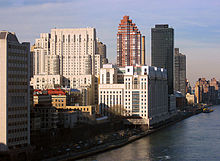
NYC Health + Hospitals (HHC) operates the public hospitals and outpatient clinics as a public benefit corporation. As of 2021[update], HHC is the largest municipal healthcare system in the United States with $10.9 billion in annual revenues,[297] HHC is the largest municipal healthcare system in the United States[needs copy edit] serving 1.4 million patients, including more than 475,000 uninsured city residents.[298] HHC was created in 1969 by the New York State Legislature as a public benefit corporation (Chapter 1016 of the Laws 1969).[299][importance?] HHC operates 11 acute care hospitals, five nursing homes, six diagnostic and treatment centers, and more than 70 community-based primary care sites, serving primarily the poor and working class. HHC's MetroPlus Health Plan is one of New York City's largest providers of government-sponsored health insurance and is the plan of choice for nearly half a million New Yorkers.[300][third-party source needed]
HHC's facilities annually provide millions of New Yorkers services interpreted in more than 190 languages.[301] The most well-known hospital in the HHC system is Bellevue Hospital, the oldest public hospital in the United States. Bellevue is the designated hospital for treatment of the President of the United States and other world leaders if they become sick or injured while in New York City.[302] The president of HHC is Ramanathan Raju, MD, a surgeon and former CEO of the Cook County health system in Illinois.[303][importance?] In August 2017, Mayor Bill de Blasio signed legislation outlawing pharmacies from selling cigarettes once their existing licenses to do so expired, beginning in 2018.[304][needs update] New York City enforces a right-to-shelter law guaranteeing shelter to anyone who needs it, regardless of their immigration, socioeconomic, or housing status, which entails providing adequate shelter and food.[305]
Public safety
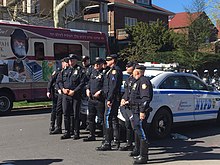
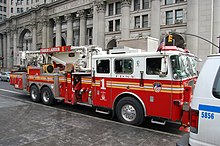
The New York Police Department (NYPD) is the largest police force in the United States by a significant margin, with more than 35,000 sworn officers.[306] Members of the NYPD are frequently referred to by politicians, the media, and their own police cars by the nickname, New York's Finest.
Crime overall has trended downward in New York City since the 1990s.[307] In 2012, the NYPD came under scrutiny for its stop-and-frisk program.[308][309][310] In 2014, New York City had the third-lowest murder rate among the largest U.S. cities,[311] having become significantly safer after a spike in crime in the 1970s through 1990s.[312] Violent crime in New York City decreased more than 75% from 1993 to 2005, and continued decreasing during periods when the nation as a whole saw increases.[313]
By 2002, New York City was ranked 197th in crime among the 216 U.S. cities with populations greater than 100,000.[313] In 1992, the city recorded 2,245 murders.[314] In 2005, the homicide rate was at its lowest level since 1966,[315] and in 2009, the city recorded fewer than 461 homicides for the first time ever since crime statistics were first published in 1963.[314] New York City has stricter gun laws than most other cities in the U.S.—a license to own any firearm is required in New York City, and the NY SAFE Act of 2013 banned assault weapons—and New York State had the fifth lowest gun death rate of the states in 2020.[316] New York City recorded 491 murders in 2021.[317]
Organized crime has long been associated with New York City, beginning with the Forty Thieves and the Roach Guards in the Five Points neighborhood in the 1820s, followed by the Tongs in the same neighborhood, which ultimately evolved into Chinatown, Manhattan. The 20th century saw a rise in the Mafia, dominated by the Five Families, as well as in gangs, including the Black Spades.[318] The Mafia and gang presence has declined in the city in the 21st century.[319][320]
The Fire Department of New York (FDNY) provides fire protection, technical rescue, primary response to biological, chemical, and radioactive hazards, and emergency medical services for the five boroughs of New York City. The fire department faces multifaceted firefighting challenges in many ways unique to New York. In addition to responding to building types that range from wood-frame single family homes to high-rise structures, the FDNY responds to fires that occur in the New York City Subway.[321] Secluded bridges and tunnels, as well as large parks and wooded areas that can give rise to brush fires, also present challenges. The FDNY is headquartered at 9 MetroTech Center in Downtown Brooklyn,[322] and the FDNY Fire Academy is on the Randalls Island.[323]
Economy

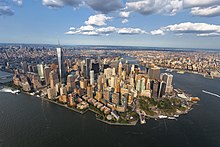
New York City is a global hub of business and commerce, and is sometimes described as the capital of the world.[325] New York is a center for worldwide banking and finance, health care and life sciences,[13] medical technology and research, retailing, world trade, transportation, tourism, real estate, new media, traditional media, advertising, legal services, accountancy, insurance, and the arts in the United States; while Silicon Alley, metonymous for New York's broad-spectrum high technology sphere, continues to expand. The Port of New York and New Jersey is a major economic engine, benefitting post-Panamax from the expansion of the Panama Canal.[326][327][328]
Many Fortune 500 corporations are headquartered in New York City,[329] as are a large number of multinational corporations. New York City has been ranked first among cities across the globe in attracting capital, business, and tourists.[330][331] New York City's role as the top global center for the advertising industry is metonymously reflected as Madison Avenue.[332] The city's fashion industry provides approximately 180,000 employees with $11 billion in annual wages.[333]
Significant other economic sectors include universities and non-profit institutions. Manufacturing declined over the 20th century but still accounts for significant employment. The city's apparel and garment industry, historically centered on the Garment District in Manhattan, peaked in 1950, when more than 323,000 workers were employed in the industry in New York. In 2015, fewer than 23,000 New York City residents were employed in the industry, although revival efforts were underway,[334] and the American fashion industry continues to be metonymized as Seventh Avenue.[335] In 2017, there were 205,592 employer firms in New York City.[336] Of those firms, 64,514 were owned by minorities, while veterans owned 5,506 of those firms, statistics pertinent to the increasing participation of U.S. firms in diversity, equity, and inclusion initiatives.[336]
In 2022, the gross domestic product of New York City was $1.053 trillion of which $781 billion or 74% was Manhattan.[9] Like other large cities, New York City has a degree of income disparity, as indicated by its Gini coefficient of 0.55 as of 2017.[337] In the first quarter of 2014,[needs update] the average weekly wage in New York County (Manhattan) was $2,749, representing the highest total among large counties in the United States.[338] In 2022, New York City was home to the highest number of billionaires of any city in the world, with a total of 107.[31] New York also had the highest density of millionaires per capita among major U.S. cities in 2014, at 4.6% of residents.[339]
New York City is one of the relatively few American cities levying an income tax (about 3%) on its residents.[340][341][342] As of 2018, there were 78,676 homeless people in New York City.[343]
Wall Street

New York City's most important economic sector lies in its role as the headquarters for the U.S. financial industry, metonymously known as Wall Street. Lower Manhattan is home to the New York Stock Exchange, at 11 Wall Street, and the Nasdaq, at 165 Broadway, representing the world's largest and second largest stock exchanges, respectively, when measured both by overall average daily trading volume and by total market capitalization of their listed companies in 2013.[344][345] In fiscal year 2013–14, Wall Street's securities industry generated 19% of New York State's tax revenue.[346]
New York City remains the largest global center for trading in public equity and debt capital markets, driven in part by the size and financial development of the U.S. economy.[347]: 31–32 [348] New York also leads in hedge fund management; private equity; and the monetary volume of mergers and acquisitions. Several investment banks and investment managers headquartered in Manhattan are important participants in other global financial centers.[347]: 34–35 New York is the principal commercial banking center of the United States.[349]
Manhattan contained over 500 million square feet (46.5 million m2) of office space in 2018,[350] making it the largest office market in the United States,[351] while Midtown Manhattan, with 400 million square feet (37.2 million m2) in 2018,[350] is the largest central business district in the world.[352]
Tech and biotech


New York is a top-tier global technology hub.[11][353] Silicon Alley, once a metonym for the sphere encompassing the metropolitan region's high technology industries,[354] is no longer a relevant moniker as the city's tech environment has expanded dramatically both in location and in scope since at least 2003, when tech business appeared in more places in Manhattan and in other boroughs, and not much silicon was involved.[354][355] New York City's current tech sphere encompasses the array of applications involving universal applications of artificial intelligence,[356][357] broadband internet,[358] new media, financial technology (fintech) and cryptocurrency, biotechnology, game design, and other fields within information technology that are supported by its entrepreneurship ecosystem and venture capital investments. Technology-driven startup companies and entrepreneurial employment are growing in New York City and the region. The technology sector has been claiming a greater share of New York City's economy since 2010.[359] Tech:NYC, founded in 2016, is a non-profit organization which represents New York City's technology industry with government, civic institutions, in business, and in the media, and whose primary goals are to further augment New York's substantial tech talent base and to advocate for policies that will nurture tech companies to grow in the city.[360]
New York City's artificial intelligence (AI) sector raised US$483.6 million in venture capital investment in 2022.[361] In 2023, New York unveiled the first comprehensive initiative to create both a framework of rules and a chatbot to regulate the use of AI within the sphere of city government.[362]
The biotechnology sector is growing in New York City, based on the city's strength in academic scientific research and public and commercial financial support. On December 19, 2011, Mayor Michael R. Bloomberg announced his choice of Cornell University and Technion-Israel Institute of Technology to build a $2 billion graduate school of applied sciences called Cornell Tech on Roosevelt Island with the goal of transforming New York City into the world's premier technology capital.[363][364]
Real estate
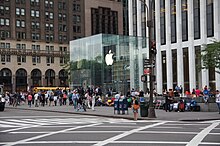
The total value of all New York City property was assessed at US$1.479 trillion for the 2017 fiscal year, an increase of 6.1% from the previous year and up 38% from the $1.072 trillion assessed for 2017; of the total market value for 2024, single family homes accounted for $765 billion (51.7%), co-ops, condos and apartment buildings totaled $351 billion (23.7%) and commercial properties were valued at $317 billion (21.4%).[367][368]
In 2014, Manhattan was home to six of the top ten ZIP codes in the United States by median housing price.[369] Fifth Avenue in Midtown Manhattan commands the highest retail rents in the world, at $3,000 per square foot ($32,000/m2) in 2017.[370] In 2019, the most expensive home sale ever in the United States achieved completion in Manhattan, at a selling price of $238 million, for a 24,000 square feet (2,200 m2) penthouse apartment overlooking Central Park.[371] In 2022, one-bedroom apartments in Manhattan rented at a median monthly price of US$3,600.00, one of the world's highest. New York City real estate is a safe haven for global investors.[29]
Tourism

Tourism is a vital industry for New York City, and NYC & Company represents the city's official bureau of tourism. New York has witnessed a growing combined volume of international and domestic tourists, reflecting over 60 million visitors to the city per year, the world's busiest tourist destination.[17] Approximately 12 million visitors to New York City have been from outside the United States, with the highest numbers from the United Kingdom, Canada, Brazil, and China. Multiple sources have called New York the most photographed city in the world.[373][374][375] I Love New York (stylized I ❤ NY) is both a logo and a song that are the basis of an advertising campaign and have been used since 1977 to promote tourism in New York City,[376] and later to promote New York State as well. The trademarked logo is owned by New York State Empire State Development.[377]
Many districts and monuments in New York City are major landmarks, including three of the world's ten-most-visited tourist attractions in 2023.[378] A record 66.6 million tourists visited New York City in 2019, bringing in $47.4 billion in tourism revenue. Visitor numbers dropped by two-thirds in 2020 during the pandemic, rebounding to 63.3 million in 2023.[379][380] Major landmarks in New York City include the Metropolitan Museum of Art, the Statue of Liberty, the Empire State Building, and Central Park.[381] Times Square is the brightly illuminated hub of the Broadway Theater District,[382] one of the world's busiest pedestrian intersections,[372] and a major center of the world's entertainment industry.[383]
Media and entertainment


New York City has been described as the entertainment[17][384][385] and digital media capital of the world.[386] It is a center for the advertising, music, newspaper, digital media, and publishing industries and is the largest media market in North America.[387] Many of the world's largest media conglomerates are based in the city, including Warner Bros. Discovery, the Thomson Reuters Corporation, the Associated Press, Bloomberg L.P., the News Corp, The New York Times Company, NBCUniversal, the Hearst Corporation, AOL, Fox Corporation, and Paramount Global. Seven of the world's top eight global advertising agency networks have their headquarters in New York.[388]
More than 200 newspapers and 350 consumer magazines have an office in the city,[389] and the publishing industry employs about 25,000 people.[390] Two of the three national daily newspapers with the largest circulations in the United States are published in New York: The Wall Street Journal and The New York Times (NYT). Nicknamed "the Grey Lady",[importance?] the NYT has won the most Pulitzer Prizes for journalism and is considered the U.S. media's newspaper of record.[391] Tabloid newspapers in the city include the New York Daily News, which was founded in 1919 by Joseph Medill Patterson,[392] and The New York Post, founded in 1801 by Alexander Hamilton.[393]
As of 2019[update], New York City was the second-largest center for filmmaking and television production in the United States, producing about 200 feature films annually, employing 130,000 individuals. The filmed entertainment industry has been growing in New York, contributing nearly $9 billion to the New York City economy alone as of 2015.[394] By volume, New York is the world leader in independent film production—one-third of all American independent films are produced there.[395][389]
New York is a major center for non-commercial educational media. NYC Media is the official public radio, television, and online media network and broadcasting service of New York City,[396] and has produced several original Emmy Award-winning shows covering music and culture in city neighborhoods and city government. The oldest public-access television channel in the United States is the Manhattan Neighborhood Network, founded in 1971.[397] WNET is the city's major public television station and a primary source of national Public Broadcasting Service (PBS) television programming. WNYC, a public radio station owned by the city until 1997, has the largest public radio audience in the United States.[398]
Culture

New York City is frequently the setting for novels, movies, and television programs and has been described as the cultural capital of the world.[399][400][401][402] In describing New York, author Tom Wolfe said, "Culture just seems to be in the air, like part of the weather."[403]
The city is the birthplace of many cultural movements, including the Harlem Renaissance in literature and visual art;[404][405] abstract expressionism (known as the New York School) in painting; and hip-hop,[173][406] punk,[407] hardcore,[408] salsa, freestyle, Tin Pan Alley, certain forms of jazz,[409] and (along with Philadelphia) disco in music. New York City has been considered the dance capital of the world.[410][411]
One of the most common traits attributed to New York City is its fast pace,[412][413][414] which spawned the term New York minute.[415] Journalist Walt Whitman characterized New York's streets as being traversed by "hurrying, feverish, electric crowds".[414] New York City's residents are prominently known for their resilience historically, and more recently related to their management of the impacts of the 9/11 terrorist attacks and the COVID-19 pandemic.[416][417][418] New York was voted the world's most resilient city in 2021 and 2022 per Time Out's global poll of urban residents.[417]
Theater

The central hub of the American theater scene is Manhattan, with its divisions of Broadway, off-Broadway, and off-off-Broadway.[419] Many movie and television stars have gotten their big break working in New York productions.[420]
Broadway theatre is one of the premier forms of English-language theatre in the world, named after Broadway, the major thoroughfare that crosses Times Square,[421] sometimes referred to as "The Great White Way".[422][423][424]
Forty-one venues in Midtown Manhattan's Theatre District, each with at least 500 seats, are classified as Broadway theatres. According to The Broadway League, Broadway shows sold approximately $1.27 billion worth of tickets in the 2013–2014 season, an 11.4% increase from $1.139 billion in the 2012–2013 season. Attendance in 2013–2014 stood at 12.21 million, representing a 5.5% increase from the 2012–2013 season's 11.57 million.[425]
The Tony Awards recognizes excellence in live Broadway theatre and are presented at an annual ceremony in Manhattan. The awards are given for Broadway productions and performances. One is also given for regional theatre. Several discretionary non-competitive awards are given as well, including a Special Tony Award, the Tony Honors for Excellence in Theatre, and the Isabelle Stevenson Award.[426]
Accent and dialect
The New York area is home to a distinctive regional accent and speech pattern called the New York dialect, alternatively known as Brooklynese or New Yorkese. It has been considered one of the most recognizable accents within American English.[427] The traditional New York area speech pattern is known for its rapid delivery, and its accent is characterized as non-rhotic so that the sound [ɹ] does not appear at the end of a syllable or immediately before a consonant, therefore the pronunciation of the city name as "New Yawk".[428] The classic version of the New York City dialect is centered on middle- and working-class New Yorkers. The influx of non-European immigrants in recent decades has led to changes in this distinctive dialect,[428] and the traditional form of this speech pattern is no longer as prevalent.[428]
Architecture

New York has architecturally noteworthy buildings in a wide range of styles and from distinct time periods, from the Dutch Colonial Pieter Claesen Wyckoff House in Brooklyn, the oldest section of which dates to 1656, to the modern One World Trade Center, the skyscraper at Ground Zero in Lower Manhattan and the most expensive office tower in the world by construction cost.[429]
Manhattan's skyline, with its many skyscrapers, is universally recognized, and the city has been home to several of the tallest buildings in the world. As of 2019[update], New York City had 6,455 high-rise buildings, the third most in the world after Hong Kong and Seoul.[430]
The character of New York's large residential districts is often defined by the elegant brownstone rowhouses and townhouses and shabby tenements that were built during a period of rapid expansion from 1870 to 1930.[431] Stone and brick became the city's building materials of choice after the construction of wood-frame houses was limited in the aftermath of the Great Fire of 1835.[432]
In contrast, New York City also has neighborhoods that are less densely populated and feature free-standing dwellings. In neighborhoods such as Riverdale (in the Bronx), Ditmas Park (in Brooklyn), and Douglaston (in Queens), large single-family homes are common in various architectural styles such as Tudor Revival and Victorian.[433][434][435]
Arts

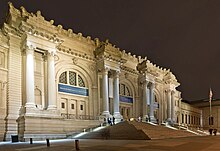
Lincoln Center for the Performing Arts, anchoring Lincoln Square on the Upper West Side of Manhattan, is home to numerous influential arts organizations, including the Metropolitan Opera, New York City Opera, New York Philharmonic, and New York City Ballet, as well as the Vivian Beaumont Theater, the Juilliard School, Jazz at Lincoln Center, and Alice Tully Hall. The Lee Strasberg Theatre and Film Institute is in Union Square, and Tisch School of the Arts is based at New York University, while Central Park SummerStage presents free music concerts in Central Park.[436]
New York City has more than 2,000 arts and cultural organizations and more than 500 art galleries.[437] The city government funds the arts with a larger annual budget than the National Endowment for the Arts.[437] The city is also home to hundreds of cultural institutions and historic sites. Museum Mile is the name for a section of Fifth Avenue running from 82nd to 105th streets on the Upper East Side of Manhattan,[438] in the upper portion of Carnegie Hill.[439]
Nine museums occupy the length of this section of Fifth Avenue, making it one of the densest displays of culture in the world.[440] Its art museums include the Guggenheim, Metropolitan Museum of Art, Neue Galerie New York, and The Africa Center. In addition to other programming, the museums collaborate for the annual Museum Mile Festival, held each year in June, to promote the museums and increase visitation.[441] Many of the world's most lucrative art auctions are held in New York City.[442][443]
The Metropolitan Museum of Art is the largest art museum in the Americas. In 2022 it welcomed 3,208,832 visitors, ranking it the third most visited U.S museum, and eighth on the list of most-visited art museums in the world.[444] Its permanent collection contains over two million works, divided among 17 curatorial departments,[445] and includes works of art from classical antiquity and ancient Egypt; paintings and sculptures from nearly all the European masters; and an extensive collection of American and modern art. The Met maintains extensive holdings of African, Asian, Oceanian, Byzantine, and Islamic art.[446]
Cuisine
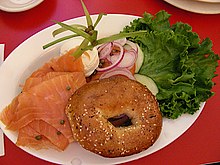
New York City's food culture includes an array of international cuisines influenced by the city's immigrant history. Central and Eastern European immigrants, especially Jewish immigrants from those regions, brought New York-style bagels, cheesecake, hot dogs, knishes, and delicatessens (delis) to the city. Italian immigrants brought New York-style pizza and Italian cuisine into the city, while Jewish immigrants and Irish immigrants brought pastrami[447] and corned beef,[448] respectively. Chinese and other Asian restaurants, sandwich joints, trattorias, diners, and coffeehouses are ubiquitous throughout the city. Some 4,000 mobile food vendors licensed by the city, many immigrant-owned, have made Middle Eastern foods such as falafel and kebabs[449] examples of modern New York street food. The city is home to "nearly one thousand of the finest and most diverse haute cuisine restaurants in the world", according to Michelin.[450] The New York City Department of Health and Mental Hygiene assigns letter grades to the city's restaurants based on inspection results.[451] As of 2019, there were 27,043 restaurants in the city, up from 24,865 in 2017.[452] The Queens Night Market in Flushing Meadows–Corona Park attracts more than ten thousand people nightly to sample food from more than 85 countries.[453]
Fashion
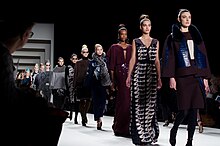
New York has frequently been ranked the top fashion capital of the world on the annual list compiled by the Global Language Monitor.[454] New York Fashion Week (NYFW) is a high-profile semiannual event featuring models displaying the latest wardrobes created by prominent fashion designers worldwide in advance of these fashions proceeding to the retail marketplace.[455]
NYFW sets the tone for the global fashion industry.[456] New York's fashion district encompasses roughly 30 city blocks in Midtown Manhattan,[457] clustered around a stretch of Seventh Avenue nicknamed Fashion Avenue.[458] New York's fashion calendar also includes Couture Fashion Week to showcase haute couture styles.[459] The Met Gala is often described as "Fashion's biggest night".[460]
Parades

New York City is well known for its street parades, the majority held in Manhattan. The primary orientation of the annual street parades is typically from north to south, marching along major avenues. The annual Macy's Thanksgiving Day Parade is the world's largest parade,[461] beginning alongside Central Park[importance?] and proceeding southward to the flagship Macy's Herald Square store;[462] the parade is viewed on telecasts worldwide and draws millions of spectators in person.[461] Other notable parades including the annual New York City St. Patrick's Day Parade in March, the NYC LGBT Pride March in June, the LGBT-inspired Greenwich Village Halloween Parade in October, and numerous parades commemorating the independence days of many nations. Ticker-tape parades celebrating championships won by sports teams as well as other accomplishments march northward along the Canyon of Heroes on Broadway from Bowling Green to City Hall Park in Lower Manhattan.
Sports
New York City is home to the headquarters of the National Football League,[463] Major League Baseball,[464] the National Basketball Association,[465] the National Hockey League,[466] and Major League Soccer.[467]
New York City hosted the 1984 Summer Paralympics and the 1998 Goodwill Games. New York City's bid to host the 2012 Summer Olympics was one of five finalists, but lost out to London.[468]
The city has played host to more than 40 major professional teams in the five sports and their respective competing leagues. Four of the ten most expensive stadiums ever built worldwide (MetLife Stadium, the new Yankee Stadium, Madison Square Garden, and Citi Field) are in the New York metropolitan area.[469]
The city is represented in the National Football League by the New York Giants and the New York Jets, although both teams play their home games at MetLife Stadium in nearby East Rutherford, New Jersey,[470] which hosted Super Bowl XLVIII in 2014.[471]
The city's two Major League Baseball teams are the New York Mets, who play at Citi Field in Queens,[472] and the New York Yankees, who play at Yankee Stadium in the Bronx. These teams compete in six games of interleague play every regular season that has come to be called the Subway Series.[needs copy edit] The Yankees have won a record 27 championships,[473] while the Mets have won the World Series twice.[474] The city was once home to the Brooklyn Dodgers (now the Los Angeles Dodgers), who won the World Series once,[475] and the New York Giants (now the San Francisco Giants), who won the World Series five times. Both teams moved to California in 1958.[476] There is one Minor League Baseball team in the city, the Mets-affiliated Brooklyn Cyclones,[477] and the city gained a club in the independent Atlantic League when the Staten Island FerryHawks began play in 2022.[478]
The city's National Basketball Association teams are the Brooklyn Nets (previously known as the New York Nets and New Jersey Nets as they moved around the metropolitan area[importance?]) and the New York Knicks, while the New York Liberty is the city's Women's National Basketball Association team. The first national college-level basketball championship, the National Invitation Tournament, was held in New York in 1938 and remains in the city.[479]
The metropolitan area is home to three National Hockey League teams. The New York Rangers, one of the league's Original Six, play at Madison Square Garden in Manhattan. The New York Islanders, traditionally representing Long Island, play in UBS Arena in Elmont, New York, but played in Brooklyn's Barclays Center from 2015 to 2020. The New Jersey Devils play at Prudential Center in nearby Newark, New Jersey.
In soccer, New York City is represented by New York City FC of Major League Soccer, who play their home games at Yankee Stadium[480] and the New York Red Bulls, who play their home games at Red Bull Arena in nearby Harrison, New Jersey.[481] NJ/NY Gotham FC plays their home games in Red Bull Arena, representing the metropolitan area in the National Women's Soccer League. A new version of the New York Cosmos was formed in 2010, and most recently played in the third-division National Independent Soccer Association before going on hiatus in January 2021. New York was a host city for the 1994 FIFA World Cup[482] and will be one of eleven US host cities for the 2026 FIFA World Cup.[483]
The annual United States Open Tennis Championships is one of the world's four Grand Slam tennis tournaments and is held at the National Tennis Center in Flushing Meadows–Corona Park, Queens.[484] The New York City Marathon, which courses through all five boroughs, is the world's largest running marathon,[485] with 51,394 finishers in 2016[486] and 98,247 applicants for the 2017 race.[485][needs update] The Millrose Games is an annual track and field meet whose featured event is the Wanamaker Mile. Boxing is a prominent part of the city's sporting scene, with events like the Amateur Boxing Golden Gloves being held at Madison Square Garden each year.[487][failed verification]
Transportation
Rapid transit
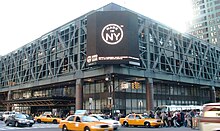
Mass transit in New York City, most of which runs 24 hours a day, accounts for one in every three users of mass transit in the United States, and two-thirds of the nation's rail riders live in the New York City metropolitan area.[490][491]
Buses
New York City's public bus fleet runs 24/7 and is the largest in North America.[492] The Port Authority Bus Terminal is the city's main intercity bus terminal and the world's busiest bus station, serving 250,000 passengers on 7,000 buses each workday in a building opened in 1950 that was designed to accommodate 60,000 daily passengers. A 2021 plan announced by the Port Authority would spend $10 billion to expand capacity and modernize the facility.[489][493][488]
Rail
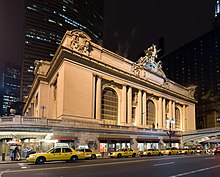
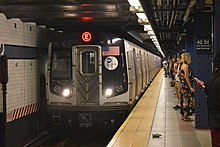
The New York City Subway system is the largest rapid transit system in the world when measured by stations in operation, with 472, and by length of routes. Nearly all of New York's subway system is open 24 hours a day, in contrast to the overnight shutdown common to systems in most cities.[494] The New York City Subway is the busiest metropolitan rail transit system in the Western Hemisphere,[495] with 1.70 billion passenger rides in 2019,[496] while Grand Central Terminal, referred to as "Grand Central Station", is the world's largest railway station by number of train platforms.[497]
Public transport is widely used in New York City. 54.6% of New Yorkers commuted to work in 2005 using mass transit.[498] This is in contrast to the rest of the United States, where 91% of commuters travel in automobiles to their workplace.[499] According to the New York City Comptroller, workers in the New York City area spend an average of 6 hours and 18 minutes getting to work each week, the longest commute time in the nation among large cities.[500] New York is the only U.S. city in which a majority (52%) of households do not have a car; only 22% of Manhattanites own a car.[501] Due to their high usage of mass transit, New Yorkers spend less of their household income on transportation than the national average, saving $19 billion annually on transportation compared to other urban Americans.[502]
New York City's commuter rail network is the largest in North America.[490] The rail network, connecting New York City to its suburbs, consists of the Long Island Rail Road, Metro-North Railroad, and New Jersey Transit. The combined systems converge at Grand Central Terminal and Pennsylvania Station and contain more than 250 stations and 20 rail lines.[490] For 24 hours a day, the elevated AirTrain system in Queens connects JFK International Airport to the New York City Subway and the Long Island Rail Road; a separate AirTrain system is planned alongside the Grand Central Parkway to connect LaGuardia Airport to these transit systems.[503][504] For inter-city rail, New York City is served by Amtrak, whose busiest station by a significant margin is New York Penn Station on the West Side of Manhattan, from which Amtrak provides connections to Boston, Philadelphia, and Washington, D.C. along the Northeast Corridor, and long-distance train service to other North American cities.[505]
The Staten Island Railway rapid transit system solely serves Staten Island, operating 24 hours a day. The Port Authority Trans-Hudson (PATH train) links Midtown and Lower Manhattan to northeastern New Jersey. Like the New York City Subway, the PATH operates 24 hours a day; meaning three of the six rapid transit systems in the world which operate on 24-hour schedules are wholly or partly in New York (the others are a portion of the Chicago "L", the PATCO Speedline serving Philadelphia, and the Copenhagen Metro).[506][507]
Multibillion-dollar heavy rail transit projects under construction in New York City include the Second Avenue Subway.[508]
Air

New York's airspace is the busiest in the United States and one of the world's busiest air transportation corridors. The three busiest airports in the New York metropolitan area include John F. Kennedy International Airport, Newark Liberty International Airport, and LaGuardia Airport; 130.5 million travelers used these three airports in 2016.[509] JFK and Newark Liberty were the busiest and fourth busiest U.S. gateways for international air passengers, respectively, in 2012; as of 2011[update], JFK was the busiest airport for international passengers in North America.[510]
Plans have advanced to expand passenger volume at a fourth airport, Stewart International Airport near Newburgh, New York, by the Port Authority of New York and New Jersey.[511] Plans were announced in July 2015 to entirely rebuild LaGuardia Airport in a multibillion-dollar project to replace its aging facilities[needs update].[512] Other commercial airports in or serving the New York metropolitan area include Long Island MacArthur Airport, Trenton–Mercer Airport and Westchester County Airport. The primary general aviation airport serving the area is Teterboro Airport.
Ferries, taxis and trams

The Staten Island Ferry is the world's busiest ferry route, carrying more than 23 million passengers from July 2015 through June 2016 on a 5.2-mile (8.4 km) route between Staten Island and Lower Manhattan and running 24/7.[513][514] Other ferry systems shuttle commuters between Manhattan and other locales within the city and the metropolitan area. NYC Ferry, a NYCEDC initiative with routes planned to travel to all five boroughs, was launched in 2017.[515]
Other features of the city's transportation infrastructure encompass 13,587 yellow taxicabs;[516] other vehicle for hire companies;[517][518] and the Roosevelt Island Tramway, an aerial tramway that transports commuters between Roosevelt Island and Manhattan Island.
Cycling network
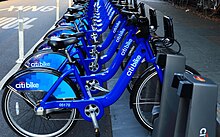
New York City has mixed cycling conditions that include urban density, relatively flat terrain, congested roadways with stop-and-go traffic, and many pedestrians. The city's large cycling population includes utility cyclists, such as delivery and messenger services; recreational cycling clubs; and an increasing number of commuters. Cycling is increasingly popular in New York City; in 2017 there were approximately 450,000 daily bike trips, compared with 170,000 in 2005.[519] As of 2017[update], New York City had 1,333 miles (2,145 km) of bike lanes, compared to 513 miles (826 km) in 2006.[519] As of 2019, there are 126 miles (203 km) of segregated or "protected" bike lanes citywide.[520]
Streets and highways

Streets are also a defining feature of the city. The Commissioners' Plan of 1811 greatly influenced its physical development. New York City has an extensive web of freeways and parkways, which link the city's boroughs to each other and to North Jersey, Westchester County, Long Island, and southwestern Connecticut through bridges and tunnels. Because these highways serve millions of outer borough and suburban residents who commute into Manhattan, it is common for motorists to be stranded for hours in traffic congestion that are a daily occurrence, particularly during rush hour.[521][522] Congestion pricing in New York City will go into effect in 2022 at the earliest[needs update].[523][524][525] Unlike the rest of the United States, New York State prohibits right or left turns on red in cities with a population greater than one million, to reduce traffic collisions and increase pedestrian safety. In New York City, therefore, all turns at red lights are illegal unless a sign permitting such maneuvers is present.[526]
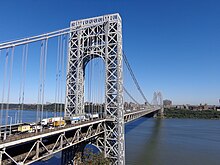
Manhattan and Staten Island are primarily coterminous with islands of the same names, while Queens and Brooklyn are at the west end of the larger Long Island, and the Bronx is on New York State's mainland. Manhattan Island is linked to New York City's outer boroughs and to New Jersey by an extensive network of bridges and tunnels. The 14-lane George Washington Bridge, connecting Manhattan to New Jersey across the Hudson River, is the world's busiest motor vehicle bridge.[527][528] The Verrazzano-Narrows Bridge, spanning the Narrows between Brooklyn and Staten Island, is the longest suspension bridge in the Americas and one of the world's longest.[529][530] The Brooklyn Bridge, with its stone neo-Gothic suspension towers, is an icon of the city itself; opened in 1883, it was the first steel-wire suspension bridge and was the longest suspension bridge in the world until 1903.[531][532] The Queensboro Bridge "was the longest cantilever span in North America" from 1909 to 1917.[533] The Manhattan Bridge, opened in 1909, "is considered to be the forerunner of modern suspension bridges", and its design "served as the model for the major long-span suspension bridges" of the early 20th century.[534] The Throgs Neck Bridge and Whitestone Bridge connect Queens and the Bronx, while the Triborough Bridge connects the three boroughs of Manhattan, Queens, and the Bronx.

The Lincoln Tunnel, which carries 120,000 vehicles a day under the Hudson River between New Jersey and Midtown Manhattan, is the busiest vehicular tunnel in the world.[535] The tunnel was built instead of a bridge to allow unfettered passage of large passenger and cargo ships that sailed through New York Harbor and up the Hudson River to Manhattan's piers. The Holland Tunnel, connecting Lower Manhattan to Jersey City, New Jersey, was the first mechanically ventilated vehicular tunnel when it opened in 1927.[536][537] The Queens–Midtown Tunnel, built to relieve congestion on the bridges connecting Manhattan with Queens and Brooklyn, was the largest non-federal project in its time when it was completed in 1940.[538] The Brooklyn–Battery Tunnel (officially known as the Hugh L. Carey Tunnel) runs underneath Battery Park and connects the Financial District in Lower Manhattan to Red Hook in Brooklyn.
Government and politics
Government


New York City has been a metropolitan municipality with a Strong mayor–council form of government[539] since its consolidation in 1898. The city government is responsible for public education, correctional institutions, public safety, recreational facilities, sanitation, water supply, and welfare services.
The City Council is a unicameral body of 51 council members whose districts are defined by geographic population boundaries.[540] Each term for the mayor and council members lasts four years and has a two consecutive-term limit,[541] which is reset after a four-year break. The New York City Administrative Code, the New York City Rules, and the City Record are the code of local laws, compilation of regulations, and official journal, respectively.[542][543]
Each borough is coextensive with a judicial district of the state Unified Court System, of which the Criminal Court and the Civil Court are the local courts, while the New York Supreme Court conducts major trials and appeals. Manhattan hosts the First Department of the Supreme Court, Appellate Division while Brooklyn hosts the Second Department. There are several extrajudicial administrative courts, which are executive agencies and not part of the state Unified Court System.
New York is divided between, and is host to the main branches of, two different U.S. district courts: the District Court for the Southern District of New York, whose main courthouse is on Foley Square near City Hall in Manhattan and whose jurisdiction includes Manhattan and the Bronx; and the District Court for the Eastern District of New York, whose main courthouse is in Brooklyn and whose jurisdiction includes Brooklyn, Queens, and Staten Island. The U.S. Court of Appeals for the Second Circuit and U.S. Court of International Trade are based in New York, also on Foley Square in Manhattan.
Politics
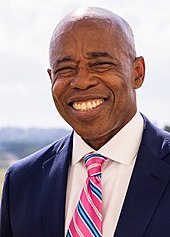
The present mayor is Eric Adams. He was elected in 2021 with 67.0% of the vote and assumed office on January 1, 2022. The Democratic Party holds the majority of public offices. As of February 2021, 67.3% of registered voters in the city are Democrats and 10.1% are Republicans.[544] New York City has not been carried by a Republican presidential candidate since President Calvin Coolidge won all five boroughs in 1924. A Republican candidate for statewide office has not won all five boroughs of the city since it was incorporated in 1898. Thirteen out of 26 U.S. congressional districts in the state of New York include portions of New York City.[545]
New York City is the most important geographical source of political fundraising in the United States. At least four of the top five ZIP Codes in the nation for political contributions were in Manhattan for the 2004, 2006, and 2008 elections. The city has a strong imbalance of payments with the national and state governments. It receives 83 cents in services for every $1 it sends to the federal government in taxes (or annually sends $11.4 billion more than it receives back). City residents and businesses also sent an additional $4.1 billion in the 2009–2010 fiscal year to the state of New York than the city received in return.[546]
International relations
In 2006, the sister city program[547] was restructured and renamed New York City Global Partners. Through this program, New York City has expanded its international outreach to a network of cities worldwide. New York's historic sister cities are denoted below by the year they joined New York City's partnership network.[548]
| New York City Global Partners network |
|---|
Africa
|
People
See also
Notes
- ^ The highest point in New York City is Todt Hill.
- ^ To distinguish it from the state of the same name
- ^ 1880 & 1890 figures include part of the Bronx. Beginning with 1900, figures are for consolidated city of five boroughs. Sources: 1698–1771,[220] 1790–1990,[221] 2000 and 2010 Censuses,[222] 2020 Census,[223] and 2022 estimate[224]
References
- ^ Nigro, Carmen. "So, Why Do We Call It Gotham, Anyway?", New York Public Library, January 25, 2011. Accessed March 3, 2023. "It is here that we learn that the term Gotham is tied to the author Washington Irving, famous for his short stories 'The Legend of Sleepy Hollow,' and 'Rip Van Winkle.' It's also here that we learn Irving was being less than flattering when he nicknamed the city in 1807."
- ^ "US Gazetteer files: 2010, 2000, and 1990". United States Census Bureau. February 12, 2011. Retrieved April 23, 2011.
- ^ "ArcGIS REST Services Directory". United States Census Bureau. Retrieved September 20, 2022.
- ^ a b "QuickFacts: New York city, New York". census.gov. United States Census Bureau. Retrieved January 21, 2023.
- ^ "New York City's Current Population Estimates and Trends – 2022" (PDF). New York City. Retrieved October 10, 2023.
- ^ "List of 2020 Census Urban Areas". census.gov. United States Census Bureau. Retrieved January 8, 2023.
- ^ "2020 Population and Housing State Data". United States Census Bureau. August 12, 2021. Retrieved November 24, 2021.
- ^ "Philippines". Philippine Statistics Authority. Retrieved May 20, 2020.
- ^ a b c d "Gross Domestic Product by County and Metropolitan Area, 2022" (PDF). www.bea.gov. Bureau of Economic Analysis.
- ^ "US Board on Geographic Names". United States Geological Survey. June 23, 2018. Retrieved January 31, 2008. Search for feature ID 975772.
- ^ a b Eisenpress, Cara (April 28, 2023). "New York is closer than ever to beating the Bay Area on tech". Crain Communications. Retrieved June 17, 2023.
- ^ a b "Top 50 science cities in life sciences". www.natureindex.com. Retrieved March 26, 2022.
- ^ a b "Governor Hochul, Mayor Adams Announce Plan for SPARC Kips Bay, First-of-Its-Kind Job and Education Hub for Health and Life Sciences Innovation". State of New York. October 13, 2022. Retrieved October 13, 2022.
- ^ "NYC Mayor's Office for International Affairs". The City of New York. Archived from the original on June 16, 2015. Retrieved June 24, 2015.
- ^ "DDC New York". Digital Diplomacy Coalition, New York. Archived from the original on July 27, 2018. Retrieved August 11, 2018.
Established in 2014, DDC New York has partnered with the United Nations, major tech and social media companies, multiple governments, and NGOs to bring unique programs to the area community.
- ^ Will Martin and Libertina Brandt (June 14, 2019). "The 21 most influential cities in the world". Business Insider. Retrieved August 9, 2023.
- ^ a b c d e Edward Robb Ellis (December 21, 2004). The Epic of New York City: A Narrative History. Basic Books. p. 593. ISBN 9780786714360. Retrieved January 2, 2023.
- ^ Roberts, Sam (September 14, 2017). "When the World Called for a Capital". The New York Times. Retrieved January 2, 2023.
- ^ a b c "Dutch Colonies". National Park Service. Retrieved July 10, 2016.
- ^ Fortenbaugh, Robert (1948). "The Nine Capitals of the United States". United States Senate. Retrieved September 7, 2008.
- ^ "Big Radius Tool: StatsAmerica". Indiana Business Research Center. Retrieved October 30, 2022.
- ^ a b Lubin, Gus (February 15, 2017). "Queens has more languages than anywhere in the world—here's where they're found". Business Insider. Retrieved December 29, 2019.
- ^ "More Foreign-Born Immigrants Live in NYC Than There Are People in Chicago". HuffPost. December 19, 2013. Retrieved April 16, 2017.
- ^ a b "The Global Financial Centres Index 34". Long Finance. September 28, 2023. Retrieved September 28, 2023.
- ^ Jones, Huw (March 24, 2022). "New York widens lead over London in top finance centres index". Reuters. Retrieved June 25, 2022.
- ^ "2021 Global Cities Report". Kearney. 2021. Retrieved July 30, 2022.
- ^ Bird, Mike (September 22, 2015). "The 25 cities with the most economic power on earth". Insider. Retrieved May 15, 2020.
- ^ Florida, Richard (May 8, 2012). "What Is the World's Most Economically Powerful City?". The Atlantic. Retrieved May 15, 2020.
- ^ a b Marc Da Silva (January 3, 2017). "International investors eye New York as safe haven". Angelsmedia. Retrieved January 30, 2023.
- ^ Goh Chiew Tong (June 7, 2023). "New York overtakes Hong Kong as the most expensive city in the world for expats, new survey shows". CNBC. Retrieved June 9, 2023.
- ^ a b McEvoy, Jemima. "Where The Richest Live: The Cities With The Most Billionaires 2022", Forbes, April 5, 2022. Accessed January 30, 2023. "New York City has taken back its crown. With 107 billionaire residents, worth over $640 billion, The Big Apple is home to more three-comma club members than any other city on the planet."
- ^ "2022 Billionaires: Cities With The Most Billionaires". Forbes. April 4, 2022. Retrieved January 27, 2023.
- ^ Fernandez, Celia (March 14, 2023). "These are the top 10 cities where the 'super-rich' own homes — 6 are in the U.S." CNBC. Retrieved March 14, 2023.
- ^ "The New York Art Market Report". Arts Economics. Retrieved January 29, 2023.
New York is the global headquarters of the art market, with the highest market share by value of art sales in the world. It is also a center of high net worth wealth, has the largest population of millionaires and billionaires globally, as well as being the key financial hub of the US.
- ^ Badoe, Etta (November 11, 2015). "1664 New Amsterdam becomes New York Dutch rulers surrender to England". Queens Chronicle. Archived from the original on February 1, 2017. Retrieved March 13, 2021.
- ^ Archdeacon, Thomas J. (2013). New York City, 1664–1710: Conquest and Change. Cornell University Press. p. 19. ISBN 978-0-8014-6891-9.
- ^ Pritchard, Evan T. (2002). Native New Yorkers: The Legacy of the Algonquin people of New York. Council Oak Books. p. 27. ISBN 1-57178-107-2.
- ^ Debo, Angie (2013). A History of the Indians of the United States. University of Oklahoma Press. p. 28. ISBN 978-0-8061-8965-9.
- ^ Rankin, Rebecca B.; Rodgers, Cleveland (1948). New York: The World's Capital City, Its Development and Contributions to Progress. Harper.
- ^ WPA Writer's Project (2004). A Maritime History of New York. Going Coastal Productions. p. 246. ISBN 0-9729803-1-8.
- ^ Lankevich, George J. (2002). New York City: A Short History. NYU Press. p. 2. ISBN 978-0-8147-5186-2.
- ^ "The Hudson River". New Netherland Institute. Retrieved July 10, 2016.
- ^ Roberts, Sam (October 2, 2012). "Honoring a Very Early New Yorker". The New York Times. Retrieved October 28, 2021.
- ^ "CUNY DSI Publishes Monograph on New York's First Immigrant". The City College of New York. May 14, 2013. Retrieved May 16, 2020.
- ^ Dutch Colonies, National Park Service. Retrieved May 19, 2007. "Sponsored by the West India Company, 30 families arrived in North America in 1624, establishing a settlement on present-day Manhattan."
- ^ GovIsland Park-to-Tolerance: through Broad Awareness and Conscious Vigilance, Tolerance Park. Retrieved February 9, 2017. See Legislative Resolutions Senate No. 5476 and Assembly No. 2708.
- ^ "Timeline: A selected Wall Street chronology". PBS. Retrieved October 28, 2021.
- ^ Binder, Frederick M.; Reimers, David M. (1996). All the Nations Under Heaven: An Ethnic and Racial History of New York City. Columbia University Press. p. 4. ISBN 0-231-07879-X.
- ^ "Pieter Schaghen Letter". S4ulanguages.com. 1626. Retrieved October 28, 2021.
"... hebben t'eylant Manhattes van de wilde gekocht, voor de waerde van 60 gulden: is groot 11000 morgen. ..." ("... They have purchased the Island Manhattes from the Indians for the value of 60 guilders. It is 11,000 morgens in size ...)
- ^ "Value of the Guilder versus Euro". International Institute of Social History. Retrieved July 25, 2019.
- ^ "Peter Schaghen Letter". Nnp.org. Archived from the original on October 23, 2010. Retrieved October 28, 2010.
- ^ Miller, Christopher L.; Hamell, George R. (September 1986). "A New Perspective on Indian-White Contact: Cultural Symbols and Colonial Trade". The Journal of American History. 73 (2): 311–328. doi:10.2307/1908224. JSTOR 1908224.
- ^ "The Patroon System". Library of Congress. Retrieved July 10, 2016.
- ^ "The Story of New Amsterdam". New Amsterdam History Center. Retrieved July 10, 2016.
- ^ Jacobs, Jaap (2009). The Colony of New Netherland: A Dutch Settlement in Seventeenth-Century America. Cornell University Press. p. 32. ISBN 978-0801475160.
- ^ Eisenstadt, Peter; Moss, Laura-Eve; Huxley, Carole F. (2005). The Encyclopedia of New York State. Syracuse University Press. p. 1051. ISBN 978-0-8156-0808-0.
- ^ a b "Peter Stuyvesant". New-York Historical Society. Archived from the original on June 24, 2016. Retrieved July 11, 2016.
- ^ a b "Peter Stuyvesant". New Netherland Institute. Retrieved July 11, 2016.
- ^ "The surrender of New Netherland, 1664". Gilder Lehrman Institute of American History. Retrieved July 11, 2016.
- ^ "Treaty of Breda". Encyclopædia Britannica. Retrieved July 10, 2016.
- ^ Homberger, Eric (2005). The Historical Atlas of New York City: A Visual Celebration of 400 Years of New York City's History. Owl Books. p. 34. ISBN 978-0-8050-7842-8.
- ^ Miller, John (2000). James II (The English Monarchs Series). Yale University Press. pp. 44–45. ISBN 978-0-300-08728-4.
- ^ Roper, L. H. (2017). Advancing Empire. Cambridge University Press. p. 215. ISBN 978-1-107-11891-1.
- ^ Van Luling, Todd (April 17, 2014). "8 Things Even New Yorkers Don't Know About New York City". HuffPost. Retrieved September 13, 2014.
- ^ Douglas, Peter. "The Man Who Took Back New Netherland" (PDF). New Netherland Institute. Retrieved July 11, 2016.
- ^ "Native Americans". Penn Treaty Museum. Retrieved October 29, 2021.
- ^ "Gotham Center for New York City History" Timeline 1700–1800
- ^ Nogueira, Pedro (2009). "The Early History of Yellow Fever (PDF)". Thomas Jefferson University.
- ^ "Timeline – Yellow Fever in America". Public Broadcasting Service (PBS). Retrieved October 30, 2021.
- ^ Foote, Thelma Wills (2004). Black and White Manhattan: The History of Racial Formation in Colonial New York City. Oxford University Press, US. p. 68. ISBN 978-0-19-508809-0.
- ^ Oltman, Adele (October 24, 2005). "The Hidden History of Slavery in New York". The Nation. Archived from the original on November 30, 2019. Retrieved July 9, 2013.
- ^ Asante, Molefi Kete; Mazama, Ama; Cérol, Marie-José (2005). Encyclopedia of Black Studies. SAGE. p. 33. ISBN 978-0-7619-2762-4.
- ^ Linder, Doug (2001). "The Trial of John Peter Zenger: An Account". University of Missouri–Kansas City. Retrieved October 30, 2021.
- ^ Moore, Nathaniel Fish (1876). An Historical Sketch of Columbia College, in the City of New York, 1754–1876. Columbia University. p. 8.
- ^ Boyer, Paul; Clark, Clifford; Hawley, Sandra; Kett, Joseph; Rieser, Andrew (2009). The Enduring Vision: A History of the American People, Volume 1: To 1877, Concise. Cengage Learning. p. 100. ISBN 978-1-111-78553-6.
- ^ Reno, Linda Davis (2008). The Maryland 400 in the Battle of Long Island, 1776. McFarland. p. 3. ISBN 978-0-7864-5184-5.
- ^ Fort Washington, American Battlefield Trust. Accessed December 31, 2023. "Fought on November 16, 1776 on the island of Manhattan, the Battle of Fort Washington was the final devastating chapter in General Washington’s disastrous New York Campaign.... Seeing how precarious the American position was, Howe launched a three-pronged assault on Fort Washington and its outer defensive works. The combined British-Hessian assault force of 8,000 men grossly outnumbered the fort’s 3,000 defenders.... At 3:00 P.M., after a fruitless attempt to gain gentler surrender terms for his men, Magaw surrendered Fort Washington and its 2,800 surviving defenders to the British."
- ^ Schenawolf, Harry. "Washington’s Retreat Across New Jersey: A British Fox Chase", Revolutionary War Journal, August 5, 2019. Accessed December 31, 2023.
- ^ Aggarwala, Rohit T. "'I want a Packet to arrive': Making New York City the headquarters of British North America 1696-1783", New York History, Winter 2017. Accessed December 29, 2023. "One of New York City's key distinctions in the late colonial period was its role as the headquarters of the British Army in North America, almost continuously from 1755 to 1783."
- ^ "Finding Freedom: Deborah", Museum of the American Revolution, May 4, 2018. Accessed December 31, 2023. "They ran to the British Army which offered freedom to enslaved people owned by rebel masters based on the 1779 Philipsburg Proclamation issued by British General Henry Clinton. Historians estimate that 10,000 enslaved people sought freedom by escaping to the British during the Revolutionary War."
- ^ Goulet, L.; and Tsaltas-Otoomanelli, Mary. "Black Loyalists In The Evacuation Of New York City, 1783", The Gotham Center for New York City History, November 15, 2023. Accessed December 31, 2023. "By 1783, New York City had become the largest fugitive slave community in North America.... Free and self-emancipated Black people entered New York City during the British occupation seeking protection."
- ^ Hinks, Peter P. (2007). Encyclopedia of Antislavery and Abolition. Greenwood Publishing Group. p. 508. ISBN 978-0-313-33144-2.
- ^ Mattera, John. Conference House Park The Daily Plant : Thursday, September 7, 2006, New York City Department of Parks and Recreation. Accessed December 29, 2023.
- ^ Trinity Church bicentennial celebration, May 5, 1897, By Trinity Church (New York, N.Y.) p. 37, ISBN 978-1-356-90825-7
- ^ New York City (NYC) The Great Fire of 1776, Baruch College. Accessed December 29, 2023. "The fire started in a wooden building near White Hall Slip, called the Fighting Cocks Tavern, a fun house visited by the city's most disreputable residents. It was fanned by winds south west of the city and spread rapidly into the night, demolishing 493 buildings and houses in the process."
- ^ "January Highlight: Superintending Independence, Part 1", Harvard University Declaration Resources Project, January 4, 2017. Accessed December 29, 2023. "From January 11, 1785 through 1789, the Congress of the Confederation met in New York City, at City Hall (which later became Federal Hall) and at Fraunces Tavern."
- ^ a b "The People's Vote: President George Washington's First Inaugural Speech (1789)". U.S. News & World Report. Archived from the original on September 25, 2008. Retrieved September 1, 2008.
- ^ "Residence Act". Web Guides: Primary Documents in American History. Library of Congress. Archived from the original on February 22, 2017. Retrieved April 23, 2017.
- ^ Fortenbaugh, Robert (1948). "The Nine Capitals of the United States". United States Senate. p. 9. Retrieved October 30, 2021.
- ^ Smil, Vaclav (2019). Growth: From Microorganisms to Megacities. The MIT Press. p. 336. ISBN 978-0-262-04283-3.
- ^ "An Act for the Gradual Abolition of Negro Slavery in New York" (L. 1799, Ch. 62)
- ^ Harper, Douglas (2003). "Emancipation in New York". Slave North. Retrieved February 6, 2013.
- ^ a b c "New York Divided: Slavery and the Civil War Online Exhibit". New-York Historical Society (physical exhibit). September 3, 2007. Archived from the original on April 14, 2012. Retrieved May 10, 2012.
- ^ Lockwood, Charles (July 23, 1978). "Quintessential Housing Of the Past: Tenements". The New York Times. Retrieved October 31, 2021.
- ^ Harris, Leslie M. "African-Americans in New York City, 1626–1863". Department of History, Emory University. Retrieved October 31, 2021.
- ^ Shorto, Russell (February 9, 2004). "The Streets Where History Lives". The New York Times. Retrieved June 19, 2013.
- ^ Rosenwaike, Ira (1972). Population History of New York City. Syracuse University Press. p. 55. ISBN 978-0-8156-2155-3.
- ^ Bridges, William (1811). Map of the City Of New York And Island Of Manhattan With Explanatory Remarks And References.; Lankevich (1998), pp. 67–68.
- ^ Mushkat, Jerome (1990). Fernando Wood: A Political Biography. Kent State University Press. p. 36. ISBN 978-0-87338-413-1.
- ^ Sarah Waxman. "History of Central Park, New York". ny.com. Retrieved October 28, 2023.
- ^ a b Appleton, Kate; Beattie, Rich; Glover, Adrien; Matthews, Lyndsey; Orcutt, April; Pramis, Joshua; Shields, Ann (November 10, 2014). "The World's Most Visited Tourist Attractions—No. 4 (tie) Central Park, New York City—Annual Visitors: 40,000,000". Travel + Leisure. Retrieved March 27, 2016.
- ^ "Cholera in Nineteenth Century New York". Virtual New York. City University of New York. Retrieved October 31, 2021.
- ^ a b c d Harris, Leslie M. (2003). "The New York City Draft Riots". In the Shadow of Slavery: African Americans in New York City, 1626–1863. University of Chicago Press. Excerpted from pages 279–288. ISBN 9780226317755.
- ^ M.G. Leonard (January 20, 1847). "H. Doc. 29-54 - Paupers and criminals. Memorial of the Corporation of the City of New York, relative to the exportation from abroad of paupers and criminals. January 25, 1847. Read, and referred to the Committee on the Judiciary". GovInfo.gov. U.S. Government Printing Office. pp. 8–9. Retrieved June 22, 2023.
'Leaving their homes,' [immigrants] say, 'with the brightest prospects,' alluring representations presented to them of the blessed state of American life, a few scanty coins in their pockets, though feeling in the enjoyment of rugged health, and surrounded by their young and innocent offspring, little did they imagine the trials to which they would be exposed; but at length they discover to their sorrow, and very natural discontent, that the foul steerage of some ocean-tossed ship is to form the filthy receptacle of persons, crowded too with hordes of human beings, with scarcely space enough to contain the half of them—certainly not more that the quarter of them comfortably; and thus huddled together en masse, they become the "emigrant passengers" destined to this country.
- ^ a b McPherson, James M.; Hogue, James Keith (2001). Ordeal by Fire: The Civil War and Reconstruction. McGraw-Hill Education. p. 399. ISBN 978-0-07-743035-1.
- ^ Cook, Adrian (1974). The Armies of the Streets: The New York City Draft Riots of 1863. University Press of Kentucky. pp. 193–195. ISBN 9780813162553.
- ^ a b Statue of Liberty, UNESCO. Accessed December 28, 2023. "Inaugurated in 1886, the sculpture stands at the entrance to New York Harbour and has welcomed millions of immigrants to the United States ever since."
- ^ The Immigrant's Statue, Statue of Liberty National Monument. Accessed December 28, 2023. "Between 1886 and 1924, almost 14 million immigrants entered the United States through New York. The Statue of Liberty was a reassuring sign that they had arrived in the land of their dreams."
- ^ "The 100 Year Anniversary of the Consolidation of the 5 Boroughs into New York City". NYC100 Centennial Celebration. Archived from the original on October 11, 2007. Retrieved October 28, 2010.
- ^ Cudahy, Brian J. (2004). The New York Subway: Its Construction and Equipment : Interborough Rapid Transit, 1904. Fordham University Press. p. 2. ISBN 978-0-8232-2401-2.
- ^ Blake, Angela M. (2009). How New York Became American, 1890–1924. Johns Hopkins University Press. pp. 63–66. ISBN 978-0-8018-8874-8.
- ^ Sheard, Bradley (1998). Lost Voyages: Two Centuries of Shipwrecks in the Approaches to New York. Aqua Quest Publications, Inc. p. 67. ISBN 978-1-881652-17-5.
- ^ "The 1911 Triangle Factory Fire". Kheel Center, Cornell University. Retrieved February 9, 2017.
- ^ Rosenwaike, Ira (1972). Population History of New York City. Syracuse University Press. Table 30. ISBN 978-0-8156-2155-3.
- ^ Gates, Henry Louis Jr.; Higginbotham, Evelyn Brooks (2009). Harlem Renaissance Lives from the African American National Biography. Oxford University Press. p. 7. ISBN 978-0-19-538795-7.
- ^ Roche, Linda De (2015). The Jazz Age: A Historical Exploration of Literature: A Historical Exploration of Literature. ABC-CLIO. pp. 18–19. ISBN 978-1-61069-668-5.
- ^ "New York Urbanized Area: Population & Density from 1800 (Provisional)". Demographia. Retrieved July 8, 2009.
- ^ Allen, Oliver E. (1993). "Chapter 9: The Decline". The Tiger—The Rise and Fall of Tammany Hall. Addison-Wesley Publishing Company. ISBN 978-0-201-62463-2.
- ^ Burns, Ric (August 22, 2003). "The Center of the World—New York: A Documentary Film (Transcript)". PBS. Archived from the original on June 23, 2011. Retrieved September 1, 2008.
- ^ a b Goicichea, Julia (August 16, 2017). "Why New York City Is a Major Destination for LGBT Travelers". The Culture Trip. Retrieved February 2, 2019.
- ^ "Workforce Diversity The Stonewall Inn, National Historic Landmark National Register Number: 99000562". National Park Service. Retrieved May 1, 2011.
- ^ Rosenberg, Eli (June 24, 2016). "Stonewall Inn Named National Monument, a First for the Gay Rights Movement". The New York Times. Retrieved June 25, 2016.
- ^ Murphy, Timothy (2013). Reader's Guide to Lesbian and Gay Studies. Routledge. p. 572. ISBN 978-1-135-94234-2.
- ^ "Brief History of the Gay and Lesbian Rights Movement in the U.S." University of Kentucky. Archived from the original on November 18, 2019. Retrieved September 2, 2017.
- ^ Frizzell, Nell (June 28, 2013). "Feature: How the Stonewall riots started the LGBT rights movement". PinkNews. Retrieved August 31, 2017.
- ^ "Stonewall riots". Encyclopædia Britannica. Retrieved August 31, 2017.
- ^ "Civil Rights at Stonewall National Monument". National Park Service. June 2016. Retrieved August 31, 2017.
- ^ "Obama inaugural speech references Stonewall gay-rights riots". North Jersey Media Group. January 21, 2013. Archived from the original on May 30, 2013. Retrieved July 2, 2013.
- ^ a b Williams, Cristan (January 25, 2013). "So, what was Stonewall?". The TransAdvocate. Retrieved March 28, 2017.
- ^ Tannenbaum, Allan (February 2004). "New York in the 70s: A Remembrance". The Digital Journalist. Archived from the original on March 20, 2012. Retrieved December 18, 2011.
- ^ Effgen, Christopher (September 11, 2001). "New York Crime Rates 1960–2009". Disastercenter.com. Retrieved October 28, 2010.
- ^ Waller, Irvin (2013). Smarter Crime Control. Rowman & Littlefield. p. 38. ISBN 978-1-4422-2170-3.
- ^ "THE YEAR 2000: THE OVERVIEW; 2000 Draws Rave Reviews After Opening Night Night Jitters". The New York Times. January 6, 2000. Retrieved October 28, 2023.
- ^ Dieterle, David A. (2017). Economics: The Definitive Encyclopedia from Theory to Practice [4 volumes]. ABC-CLIO. p. 396. ISBN 978-0-313-39708-0.
- ^ "Missing Doctor Added to List of 9/11 Victims". The New York Sun. New York: TWO SL LLC. Associated Press. July 10, 2008. Archived from the original on December 5, 2008. Retrieved February 21, 2013.
- ^ Greenspan, Elizabeth (2013). Battle for Ground Zero: Inside the Political Struggle to Rebuild the World Trade Center. St. Martin's Press/Harvard University. p. 152. ISBN 978-1-137-36547-7.
- ^ "World Trade Center Transportation Hub". Port Authority of New York and New Jersey. Archived from the original on January 3, 2020. Retrieved February 9, 2017.
The state-of-the-art World Trade Center Transportation Hub, completed in 2016, serves 250,000 Port Authority Trans-Hudson (PATH) daily commuters and millions of annual visitors from around the world. At approximately 800,000 square feet, the Hub, designed by internationally acclaimed architect Santiago Calatrava, is the third-largest transportation center in New York City.
- ^ Hetter, Katia; Boyette, Chris (November 12, 2013). "It's official: One World Trade Center to be tallest U.S. skyscraper". CNN. Retrieved March 1, 2014.
- ^ "New York City Skyscraper Diagram". SkyscraperPage.com. Skyscraper Source Media. Retrieved January 22, 2013.
- ^ "One World Trade Center". SkyscraperPage.com. Skyscraper Source Media. Retrieved February 9, 2017.
The roof height is the same as original One World Trade Center. The building is topped out by a 124-meter (408-foot) spire. So the tower rises 1,776 feet (541-meter) which marks the year of the American declaration of Independence.
- ^ Lesser, Benjamin (April 30, 2012). "It's official: 1 World Trade Center is now New York's tallest skyscraper". Daily News. New York. Retrieved January 22, 2013.
- ^ Nocera, Joe (September 14, 2012). "Two Days in September". The New York Times. Retrieved May 6, 2017.
On the left, that anger led, a year ago, to the rise of the Occupy Wall Street movement. Thus, Anniversary No. 2: Sept. 17, 2011, was the date Occupy Wall Street took over Zuccotti Park in Lower Manhattan, which soon led to similar actions in cities across the country. The movement's primary issue was income inequality—"We are the 99 percent", they used to chant.
- ^ a b Eshelman, Robert S. (November 15, 2012). "Adaptation: Political support for a sea wall in New York Harbor begins to form". Environment & Energy Publishing, LLC. Archived from the original on July 2, 2015. Retrieved July 23, 2015.
- ^ West, Melanie Grayce (March 1, 2020). "First Case of Coronavirus Confirmed in New York State". The Wall Street Journal. ISSN 0099-9660. Retrieved July 10, 2020.
- ^ Jackson, Kenneth T.; Keller, Lisa; Flood, Nancy (2010). The Encyclopedia of New York City: Second Edition. Yale University Press. p. 2384. ISBN 978-0-300-18257-6.
- ^ "Remnants of an Ice Age, The Wisconsin Ice Sheet Continues Its Journey". New York City Department of Parks and Recreation. Retrieved August 8, 2015.
- ^ "The Hudson River Estuary". Life.bio.sunysb.edu. Stony Brook University. Archived from the original on June 4, 2017. Retrieved August 20, 2011.
- ^ Berger, Joseph (July 19, 2010). "Reclaimed Jewel Whose Attraction Can Be Perilous". The New York Times. Retrieved July 21, 2010.
- ^ Gillespie, Angus K. (1999). Twin Towers: The Life of New York City's World Trade Center. Rutgers University Press. p. 71. ISBN 978-0-7838-9785-1.
- ^ Lopate, Phillip (2005). Waterfront: A Walk Around Manhattan. Anchor Press. ISBN 978-0-385-49714-5.
- ^ New York State Gazetteer from 2010 United States Census, United States Census Bureau. Retrieved February 9, 2017.
- ^ Roberts, Sam (May 22, 2008). "It's Still a Big City, Just Not Quite So Big". The New York Times. Retrieved May 22, 2008.
- ^ Lundrigan, Margaret (2004). Staten Island: Isle of the Bay. Arcadia Publishing. p. 10. ISBN 978-0-7385-2443-6.
- ^ Howard, David (2002). Outside Magazine's Urban Adventure New York City. W.W. Norton & Company. p. 35. ISBN 978-0-393-32212-5.
- ^ "The Five Boroughs of the City of New York: A Brief Historical Description". The History Box. October 7, 2017. Archived from the original on October 7, 2017. Retrieved July 10, 2020.
- ^ Carlson, Jen (May 21, 2012). "Do You Refer To Manhattan As "The City"?". Gothamist. Archived from the original on October 25, 2016. Retrieved August 20, 2017.
- ^ a b c Highest Density States, Counties and Cities (2022), United States Census Bureau. Accessed December 30, 2023.
- ^ Barry, Dan (October 11, 2001). "A Nation challenged: in New York; New York Carries On, but Test of Its Grit Has Just Begun". The New York Times. Retrieved March 27, 2016.
A roaring void has been created in the financial center of the world.
- ^ Sorrentino, Christopher (September 16, 2007). "When He Was Seventeen". The New York Times. Retrieved March 27, 2016.
In 1980 there were still the remains of the various downtown revolutions that had reinvigorated New York's music and art scenes and kept Manhattan in the position it had occupied since the 1940s as the cultural center of the world.
- ^ Immerso, Michael (2002). Coney Island: The People's Playground. Rutgers University Press. p. 3. ISBN 978-0-8135-3138-0.
- ^ Hughes, C.J. (August 17, 2016). "Marine Park, Brooklyn: Block Parties, Bocce and Salt Air". The New York Times. Retrieved October 29, 2017.
The neighborhood of Marine Park, a compact enclave in southeast Brooklyn, has a major claim to fame. It sits next to the borough's largest park, Marine Park
- ^ "19 Reasons Why Brooklyn Is New York's New Startup Hotspot". CB Insights. October 19, 2015. Retrieved August 27, 2017.
- ^ a b Friedman, Vanessa (April 30, 2016). "Brooklyn's Wearable Revolution". The New York Times. Retrieved August 27, 2017.
- ^ Symonds, Alexandria (April 29, 2016). "One Celebrated Brooklyn Artist's Futuristic New Practice". The New York Times. Retrieved August 27, 2017.
- ^ "Military Bases in the Continental United States" (PDF). Nps.gov. Archived from the original (PDF) on September 2, 2011. Retrieved February 20, 2012.
- ^ Jackson, Kenneth T., ed. (2010). The History of New York City (2nd ed.). Yale University Press. p. 30. ISBN 978-0-300-11465-2.
- ^ O'Donnell, Michelle (July 4, 2006). "In Queens, It's the Glorious 4th, and 6th, and 16th, and 25th ..." The New York Times. Retrieved July 20, 2014.
- ^ Kim, Christine. "Queens, New York, Sightseeing". USA Today. Retrieved March 20, 2016.
- ^ a b Weber, Andrew (April 30, 2013). "Queens". NewYork.com. Archived from the original on May 13, 2015. Retrieved March 20, 2016.
- ^ Frazier, Ian (June 26, 2006). "Utopia, the Bronx". The New Yorker. Retrieved September 1, 2008.
- ^ "Animals & Exhibits". Bronx Zoo. Wildlife Conservation Society. Archived from the original on January 14, 2015. Retrieved March 20, 2016.
- ^ Ward, Candace (2000). New York City Museum Guide. Dover Publications. p. 72. ISBN 978-0-486-41000-5.
- ^ a b Toop, David (1992). Rap Attack 2: African Rap to Global Hip Hop. Serpent's Tail. ISBN 978-1-85242-243-1.
- ^ a b Foderaro, Lisa W. (May 31, 2013). "How Big Is That Park? City Now Has the Answer". The New York Times. Retrieved May 31, 2013.
- ^ "Staten Island Greenbelt". NYNJTC.org. New York–New Jersey Trail Conference. Retrieved October 28, 2010.
- ^ Peel, M.C.; Finlayson, B.L.; McMahon, T.A. "World Map of Köppen-Geiger climate classification". The University of Melbourne. Archived from the original on January 13, 2015. Retrieved April 26, 2013.
- ^ "New York Polonia Polish Portal in New York". NewYorkPolonia.com. Retrieved April 26, 2013.
- ^ "Average monthly hours of sunshine in New York City (NY)". World Weather & Climate Information. Retrieved January 1, 2024.
On average, the total annual amount of sun is 2540 hours.
- ^ Weather in New York, Climate and Weather. Accessed December 31, 2023. "Sprawling across three islands at the mouth of the Hudson River in the north-eastern United States, New York City’s climate benefits from the warm Gulf Stream of the Atlantic Ocean. This, coupled with the protection of the Appalachian Mountains inland, keep the city warmer than other big American cities at similar latitudes."
- ^ a b c "New York, NY". United States National Weather Service. Retrieved July 30, 2022.
- ^ "The Climate of New York". Cornell University. Archived from the original on April 12, 2008. Retrieved July 6, 2012.
- ^ Maldonando, Samantha. "How Much Hotter Is NYC’s Heat Island Effect Making Your Neighborhood?", The City, July 26, 2023. Accessed December 30, 2023. "The city as a whole feels about 9.5 degrees hotter for the average New Yorker. That’s thanks to the human-made surroundings that define the cityscape: tall buildings that limit air circulation, abundant asphalt and pavement and the heat-generating things New Yorkers do fairly close to one another, like running appliances and driving."
- ^ a b "NowData – NOAA Online Weather Data". National Oceanic and Atmospheric Administration. Retrieved May 4, 2021.
- ^ "Summary of Monthly Normals 1991–2020". National Oceanic and Atmospheric Administration. Archived from the original on May 4, 2021. Retrieved May 4, 2021.
- ^ "New York Central Park, NY Climate Normals 1961−1990". National Oceanic and Atmospheric Administration. Retrieved July 18, 2020.
- ^ "New York, New York, USA - Monthly weather forecast and Climate data". Weather Atlas. Retrieved July 4, 2019.
- ^ "Days below 0°F in New York City". Weather 2000. Retrieved June 24, 2021.
- ^ Pollak, Michael (January 10, 2014). "Determining New York City's Record Wind Chill". The New York Times. Retrieved November 5, 2021.
- ^ "New York City Sea Temperature—United States—Sea Temperatures". World Sea Temperatures. Retrieved November 5, 2021.
- ^ Dolnick, Sam (August 28, 2011). "Damage From Irene Largely Spares New York—Recovery Is Slower in New York Suburbs". The New York Times. Retrieved November 5, 2021.
- ^ "Superstorm Sandy blamed for at least 11 U.S. deaths as it slams East Coast". CNN. October 29, 2012. Archived from the original on January 20, 2013. Retrieved January 22, 2013.
- ^ "ParkScore 2018: City Rankings". Trust for Public Land. Archived from the original on October 13, 2018. Retrieved November 8, 2018.
- ^ "Discover the truly wild side of New York's metropolitan area". nps.gov. Retrieved June 11, 2012.
- ^ "New York State Office of Parks, Recreation and Historic Preservation, New York City Region". Nysparks.state.ny.us. Archived from the original on February 15, 2011. Retrieved October 28, 2010.
- ^ "Marsha P. Johnson State Park (East River State Park)". New York State Office of Parks, Recreation and Historic Preservation. Retrieved October 4, 2021.
- ^ "Mayor Giuliani Announces Amount of Parkland in New York City has Passed 28,000-acre (110 km2) Mark". New York City Mayor's Office. February 3, 1999. Retrieved September 1, 2008.; "Beaches". New York City Department of Parks & Recreation. Retrieved September 1, 2008.
- ^ "Pelham Bay Park". New York City Department of Parks and Recreation. Retrieved June 8, 2012.
- ^ Mann, Ted (September 19, 2012). "New Cab Plan Curbs Hybrids". The Wall Street Journal. Retrieved September 23, 2012.
- ^ Szczepanski, Mallory (July 21, 2017). "Behind the Scenes of Sims Municipal Recycling's MRF in Brooklyn". Waste360. Retrieved January 5, 2022.
- ^ Paben, Jared (January 11, 2022). "Closed Loop picks up a MRF operator with strong financials – Resource Recycling". Resource Recycling News. Retrieved February 21, 2022.
- ^ "Mayor Adams, Trust For Governors Island Unveil Finalist Proposals For Climate Solutions Center". City of New York. October 26, 2022. Retrieved October 28, 2022.
- ^ "Mayor de Blasio Commits to 80 Percent Reduction of Greenhouse Gas Emissions by 2050, Starting with Sweeping Green Buildings Plan". City of New York. September 21, 2014. Retrieved October 31, 2014.
- ^ Newman, Andy (July 27, 2010). "Appeals Court Rejects Effort to Create Hybrid Taxi Fleet". The New York Times. Retrieved July 31, 2010.
- ^ "Bicycling in New York City: Know the Facts". Transportation Alternatives. Archived from the original on January 23, 2020. Retrieved October 31, 2014.
- ^ Jervey, Ben (2006). The Big Green Apple: Your Guide to Eco-Friendly Living in New York City. Globe Pequot Press. ISBN 978-0-7627-3835-9.
- ^ "2001 National Household Travel Survey: Summary of Travel Trends" (PDF). U.S. Department of Transportation. December 2004. Retrieved September 1, 2008.
- ^ Florida, Richard (April 7, 2015). "2015's Most Walkable U.S. Cities". The Atlantic. MSN. Archived from the original on April 11, 2015. Retrieved April 12, 2015.
- ^ "NYC tops list of most walkable cities in America—video narrative by Mara Montalbano". Buzz60, on MSN. Archived from the original on October 24, 2015. Retrieved April 11, 2015.
- ^ "The 10 Most Walkable U.S. Cities". MarketWatch. 2011. Retrieved July 20, 2011.
- ^ Ladyzhets, Betsy (April 18, 2018). "Most walkable cities in America". Stacker, via MSN. Retrieved May 18, 2018.
- ^ Hamblin, James (June 28, 2013). "The Summer Bicycles Took Control". The Atlantic Monthly. The Atlantic Monthly Group. Retrieved June 28, 2013.
- ^ "2014 NYC In-Season Cycling Indicator" (PDF). City of New York. Retrieved March 15, 2019.
- ^ "Current Reservoir Levels". New York City Department of Environmental Protection. Retrieved August 15, 2014.
- ^ Lustgarten, Abrahm (August 6, 2008). "City's Drinking Water Feared Endangered; $10B Cost Seen". The New York Sun. Archived from the original on August 20, 2016. Retrieved August 9, 2008.
- ^ Hu, Winnie (January 18, 2018). "A Billion-Dollar Investment in New York's Water". The New York Times. Retrieved January 18, 2018.
- ^ New York Water Fact Sheet, United States Environmental Protection Agency. June 2010. Accessed December 29, 2023. "New York City is home to the largest engineered water system in the nation, supplying more than 1 billion gallons of water each day to approximately 9 million people, representing half of the state’s population. The city draws its water from reservoirs upstate, supplied by a 1,900-square mile watershed—that’s about the size of Delaware."
- ^ "WHO Global Ambient Air Quality Database (update 2018)". World Health Organization. Retrieved January 16, 2022.
- ^ "Ambient (outdoor) air quality and health". World Health Organization. Retrieved January 16, 2022.
- ^ "Air Pollution Monitoring". New York City Department of Environmental Protection. Archived from the original on March 5, 2019. Retrieved January 16, 2022.
- ^ Greene and Harrington (1932). American Population Before the Federal Census of 1790. New York.
{{cite book}}: CS1 maint: location missing publisher (link), as cited in: Rosenwaike, Ira (1972). Population History of New York City. Syracuse, N.Y.: Syracuse University Press. p. 8. ISBN 0-8156-2155-8. - ^ Gibson, Campbell.Population of the 100 Largest Cities and Other Urban Places in the United States:1790 to 1990, United States Census Bureau, June 1998. Retrieved June 12, 2007.
- ^ "Table PL-P1 NYC: Total Population New York City and Boroughs, 2000 and 2010" (PDF). nyc.gov. Retrieved May 16, 2016.
- ^ a b "QuickFacts: New York city, New York". U.S. Census Bureau. Retrieved August 17, 2021. Cite error: The named reference "2020Census" was defined multiple times with different content (see the help page).
- ^ "New York City's Current Population Estimates and Trends - 2022" (PDF). New York City. Retrieved May 9, 2023.
- ^ Barron, James (March 22, 2018). "New York City's Population Hits a Record 8.6 Million". The New York Times. Retrieved March 22, 2018.
- ^ Sherry, Virginia N. (March 27, 2014). "Staten Island population at all-time high of 473,000; NYC's soars to record 8.4 million". Staten Island Advance. Retrieved March 27, 2014.
- ^ Roberts, Sam (March 14, 2013). "Fewer People Are Abandoning the Bronx, Census Data Show". The New York Times. Retrieved March 27, 2014.
- ^ "Fastest-Growing Cities Are Still in the West and South", United States Census Bureau, May 26, 2022. Accessed December 30, 2023.
- ^ Castronuovo, Celine (August 12, 2021). "All 10 largest cities grew, Phoenix supplants Philly as 5th largest in US". The Hill. Retrieved August 28, 2021.
- ^ Dorman, John L. (August 16, 2021). "Census: The 10 most populous US cities are led by NYC, Los Angeles, and Chicago; Phoenix leapfrogs Philadelphia to claim the No. 5 spot". Business Insider. Retrieved August 27, 2021.
- ^ "ACS Demographic and Housing Estimates—2012–2016 American Community Survey 5-Year Estimates—City Versus State". American Fact Finder, United States Census Bureau. 2016. Archived from the original on February 14, 2020. Retrieved October 8, 2018.
- ^ "ACS Demographic and Housing Estimates—2012–2016 American Community Survey 5-Year Estimates—City Versus Metro". American Fact Finder, United States Census Bureau. 2016. Archived from the original on February 14, 2020. Retrieved October 8, 2018.
- ^ Correal, Annie (August 12, 2021). "New York City adds 629,000 people, defying predictions of its decline". The New York Times. Archived from the original on December 28, 2021. Retrieved August 27, 2021.
- ^ "Endangered Language Alliance". 2012. Retrieved September 7, 2013.
- ^ "Linguistics- Say what?". The Economist. September 10, 2011. Retrieved October 24, 2013.
- ^ N. R. Kleinfield (January 15, 2016). "New Yorkers, Self-Assured and Opinionated, Defend Their Values". The New York Times. Archived from the original on January 18, 2016. Retrieved January 15, 2016.
- ^ "Supplemental Table 2. Persons Obtaining Lawful Permanent Resident Status by Leading Core Based Statistical Areas (CBSAs) of Residence and Region and Country of Birth: Fiscal Year 2014". U.S. Department of Homeland Security. Archived from the original on August 4, 2016. Retrieved June 1, 2016.
- ^ "2020 Decennial Census". U.S. Census Bureau. Retrieved February 11, 2022.
- ^ "QuickFacts: New York city, New York". United States Census Bureau. Retrieved November 1, 2023.
- ^ a b Semple, Kirk (June 8, 2013). "City's Newest Immigrant Enclaves, From Little Guyana to Meokjagolmok it". The New York Times. Retrieved June 12, 2013.
- ^ The Newest New Yorkers: 2013, New York City Department of City Planning, December 2013. Retrieved February 9, 2017. "The immigrant share of the population has also doubled since 1965, to 37 percent. With foreign-born mothers accounting for 51 percent of all births, approximately 6-in-10 New Yorkers are either immigrants or the children of immigrants."
- ^ Semple, Kirk (December 18, 2013). "Immigration Remakes and Sustains City, a Report Concludes". The New York Times. Retrieved December 18, 2013.
- ^ Lubin, Gus (February 15, 2017). "Queens Has More Languages Than Anywhere in the World – Here's Where They're Found". Business Insider. Retrieved January 4, 2023.
- ^ a b "Yearbook of Immigration Statistics: 2011 Supplemental Table 2". U.S. Department of Homeland Security. Retrieved July 18, 2014.
- ^ "Hispanic or Latino by Type: 2010". United States Census Bureau. Archived from the original on February 12, 2020. Retrieved October 8, 2014.
- ^ "Persons Obtaining Lawful Permanent Resident Status by Leading Core Based Statistical Areas (CBSAs) of Residence and Region and Country of Birth: Fiscal Year 2013". United States Department of Homeland Security. Archived from the original on July 12, 2014. Retrieved March 6, 2015.
- ^ "Asian American Statistics". Améredia Incorporated. Retrieved July 5, 2011.
- ^ Semple, Kirk (June 23, 2011). "Asian New Yorkers Seek Power to Match Numbers". The New York Times. Retrieved July 5, 2011.
Asians, a group more commonly associated with the West Coast, are surging in New York, where they have long been eclipsed in the city's kaleidoscopic racial and ethnic mix. For the first time, according to census figures released in the spring, their numbers have topped one million—nearly one in eight New Yorkers—which is more than the Asian population in the cities of San Francisco and Los Angeles combined.
- ^ Vivian Yee (February 22, 2015). "Indictment of New York Officer Divides Chinese-Americans". The New York Times. Retrieved November 17, 2023.
Now they are reaching out to the Chinese-language press, contacting lawyers to advise Officer Liang and planning a protest march in New York, a city with the largest Chinese population outside of Asia.
- ^ * "Chinatown New York City Fact Sheet" (PDF). www.explorechinatown.com. Retrieved August 28, 2022.
- Waxman, Sarah. "The History of New York's Chinatown". Mediabridge Infosystems, Inc. Retrieved August 28, 2022.
Manhattan's Chinatown, the largest Chinatown in the United States and the site of the largest concentration of Chinese in the Western Hemisphere, is located on the Lower East Side.
- Reimers, David M. (1992). Still the golden door: the Third ... – Google Books. Columbia University Press. ISBN 9780231076814. Retrieved August 28, 2022.
- Lawrence A. McGlinn, Department of Geography SUNY-New Paltz. "Beyond Chinatown: Dual immigration and the Chinese population of metropolitan New York City, 2000, Page 4" (PDF). Middle States Geographer, 2002, 35: 110–119, Journal of the Middle States Division of the Association of American Geographers. Archived from the original (PDF) on October 29, 2012. Retrieved August 28, 2022.
- Reimers, David M. (1992). Still the golden door: the Third ... – Google Books. Columbia University Press. ISBN 9780231076814. Retrieved August 28, 2022.
- Waxman, Sarah. "The History of New York's Chinatown". Mediabridge Infosystems, Inc. Retrieved August 28, 2022.
- ^ "Most Significant Unreached People Group Communities in Metro NY". GLOBAL GATES. July 17, 2012. Archived from the original on October 27, 2014. Retrieved October 27, 2014.
- ^ "A Community of Many Worlds: Arab Americans in New York City". Allied Media Corp. Archived from the original on November 8, 2014. Retrieved October 9, 2014.
- ^ "Yearbook of Immigration Statistics: 2013 Lawful Permanent Residents Supplemental Table 2". U.S. Department of Homeland Security. Retrieved July 19, 2014.
- ^ "Explore Census Data". United States Census Bureau. Retrieved October 31, 2023.
- ^ "American FactFinder—Results". U.S. Department of Commerce. Archived from the original on February 12, 2020. Retrieved October 8, 2014.
- ^ Brennan Ortiz (2014). "NYC's Micro Neighborhoods: Little Odesa in Brighton Beach, Brooklyn". Untapped Cities (online, January 23). Retrieved October 22, 2023.
- ^ Richard F. Shepard (November 15, 1991). "Astoria, a Greek Isle in the New York City Sea". The New York Times. Retrieved October 22, 2023.
- ^ Kerry Kolasa-Sikiaridi (June 18, 2022). "Astoria: The Ever-Changing Greektown of New York". Greek Reporter. Retrieved October 22, 2023.
- ^ "Transcript: Mayor Eric Adams Discusses Coordinated Efforts That Stopped Potential Attack on Jewish Community". Nyc.gov. November 21, 2022.
- ^ Danailova, Hilary (January 2018). "Brooklyn, the Most Jewish Spot on Earth". Hadassah Magazine.
- ^ Minkoff, Peter (April 5, 2018). "New York – The World's Gay Capital". Your LGBTQ+ Voice. Retrieved January 4, 2023.
- ^ Gates, Gary J. (October 2006). "Same-sex Couples and the Gay, Lesbian, Bisexual Population: New Estimates from the American Community Survey" (PDF). The Williams Institute on Sexual Orientation Law and Public Policy. Archived from the original (PDF) on June 9, 2013. Retrieved December 7, 2013.
- ^ Silverman, Brian; Chauvin, Kelsy (2013). Frommer's New York City 2013. John Wiley & Sons. ISBN 978-1-118-33144-6. Retrieved March 24, 2015.
- ^ People v. Ronald Onofre, 51 N.Y.2d 476 (N.Y. Court of Appeals December 18, 1980).
- ^ Confessore, Nicholas; Barbaro, Michael (June 24, 2011). "New York Allows Same-Sex Marriage, Becoming Largest State to Pass Law". The New York Times. Retrieved September 2, 2012.
- ^ a b "Revelers Take to the Streets For 48th Annual NYC Pride March". CBS New York. June 25, 2017. Retrieved June 26, 2017.
A sea of rainbows took over the Big Apple for the biggest pride parade in the world Sunday.
- ^ Gleason, Will (March 11, 2019). "Citing its diversity and culture, NYC was voted best city in the world in new global survey". Time Out. Retrieved May 19, 2019.
After compiling the thoughts of over 30,000 people, both from our NYC readership and half-a-world away, New York was voted the greatest city on the planet for 2019. In a hint as to why this happened, and why now, it also lead [sic] the categories of most diverse metropolis and best culture.
- ^ a b Parry, Bill (July 10, 2018). "Elmhurst vigil remembers transgender victims lost to violence and hate". TimesLedger. New York. Archived from the original on February 13, 2019. Retrieved April 13, 2019.
- ^ Allen, Karma (July 3, 2019). "About 5 million people attended WorldPride in NYC, mayor says". ABC News. Retrieved July 3, 2019.
- ^ Patil, Anushka (June 15, 2020). "How a March for Black Trans Lives Became a Huge Event". The New York Times. Retrieved June 28, 2020.
- ^ Keating, Shannon (June 16, 2020). "Corporate Pride Events Can't Happen This Year. Let's Keep It That Way". BuzzFeed News. Retrieved June 28, 2020.
- ^ a b Lipka, Michael (July 29, 2015). "Major U.S. metropolitan areas differ in their religious profiles". Pew Research Center. Retrieved July 30, 2015.
- ^ a b "Religion in America: U.S. Religious Data, Demographics and Statistics". Pew Research Center's Religion & Public Life Project. Retrieved July 11, 2020.
- ^ "Transcript: Mayor Eric Adams Discusses Coordinated Efforts That Stopped Potential Attack on Jewish Community". City of New York. November 21, 2022. Retrieved November 24, 2022.
New York City is home to 1.6 million Jews, the largest Jewish population of any city in the world.
- ^ "Jewish Community Study of New York: 2011 Comprehensive Report" (PDF). UJA-Federation of New York. Archived from the original (PDF) on November 16, 2021. Retrieved August 13, 2014.
- ^ Weichselbaum, Simone (June 26, 2012). "Nearly one in four Brooklyn residents are Jews, new study finds". Daily News. New York. Archived from the original on July 4, 2018. Retrieved May 30, 2013.
- ^ Danailova, Hilary (January 11, 2018). "Brooklyn, the Most Jewish Spot on Earth". Hadassah Magazine. Retrieved July 29, 2020.
- ^ Nathan-Kazis, Josh (June 12, 2012). "N.Y. Jewish Population Grows to 1.5M: Study". The Forward. Retrieved November 21, 2021.
- ^ Grynbaum, Michael M.; Otterman, Sharon (March 4, 2015). "New York City Adds 2 Muslim Holy Days to Public School Calendar". The New York Times. Retrieved March 4, 2015.
- ^ "An Impact Report of Muslim Contributions to New York City" (PDF). Institute for Social Policy and Understanding. Retrieved May 17, 2021.
- ^ "Muslims in Metro New York (Part 2) – Specific Muslim Group Estimates". Global Gates. February 29, 2016. Retrieved September 16, 2022.
- ^ Hussain, Tharik (May 19, 2016). "How America's oldest mosque was built by Muslims from the Baltic". www.baltictimes.com. The Baltic Times. Retrieved July 29, 2020.
- ^ Siddiqui, Zuha (December 26, 2018). "America's Oldest Surviving Mosque Is in Williamsburg". Bedford + Bowery. Retrieved July 29, 2020.
- ^ "Religious composition of adults in the New York City metropolitan area". Pew Research Center. Retrieved February 1, 2023.
- ^ "Where we live NRC Fair housing together". Retrieved July 23, 2023.
- ^ "Home". New York City Charter School Center. Retrieved April 16, 2015.
- ^ "Private School Universe Survey". National Center for Education Statistics. Retrieved September 1, 2008.
- ^ a b "Nation's Largest Libraries". LibrarySpot. Archived from the original on May 29, 2007. Retrieved September 1, 2008.
- ^ "America's Biggest College Towns". Bloomberg.com. September 8, 2016. Retrieved August 15, 2022.
- ^ "Academics". City University of New York. Retrieved April 15, 2020.
- ^ "Academic Ranking of World Universities 2019". Shanghai Ranking Consultancy. Archived from the original on August 17, 2019. Retrieved August 17, 2019.
- ^ "Academic Ranking of World Universities 2017". Shanghai Ranking Consultancy Consultancy. Archived from the original on October 12, 2017. Retrieved October 16, 2017.
- ^ "CWUR 2016—World University Rankings". Center for World University Rankings. Retrieved October 16, 2017.
- ^ Horner, Blair; Levin, Arthur; Mattei, Suzanne (August 2014). "The Doctor Is In: New York's Increasing Number of Doctors" (PDF). Casey Ciceron (contributor). New York City Economic Development Corporation. p. 13, Appendix 1: Comparison of the Numbers Of New York Doctors By County, As Of December 31, 2004, And December 31, 2012. Retrieved August 22, 2014.
- ^ "Mayor Michael R. Bloomberg and Economic Development Corporation President Andrew M. Alper Unveil Plans to Develop Commercial Bioscience Center in Manhattan" (Press release). New York City Economic Development Corporation. November 18, 2004. Archived from the original on October 11, 2007. Retrieved September 1, 2008.
- ^ "About Us: Locations". NewYork-Presbyterian Hospital. Archived from the original on August 12, 2014. Retrieved August 12, 2014.
- ^ "Financial Statements and Supplemental Schedules and Report of Independent Certified Public Accountants – New York City Health and Hospitals Corporation (A Component Unit of the City of New York)" (PDF). The City of New York. Retrieved October 12, 2022.
- ^ "HHC Health and Hospitals Corporation". nyc.gov. Retrieved November 29, 2021.
- ^ "The History of New York City's Municipal Hospitals". New York City Health and Hospitals Corporation. Archived from the original on February 22, 2012. Retrieved November 29, 2021.
- ^ "MetroPlus Health". MetroPlus. Retrieved November 29, 2021.
- ^ "2014 HHC Report to the Community" (PDF). New York City Health and Hospitals Corporation. Retrieved March 10, 2017.
- ^ "New York City Health and Hospitals Corporation History". Funding Universe. Retrieved October 8, 2014.
- ^ Mogul, Fred (January 21, 2014). "CEO of Chicago Public Hospitals to Take the Helm of HHC". WNYC. Retrieved October 8, 2014.
- ^ Goldman, Henry; Kaplan, Jennifer (August 28, 2017). "NYC Boosts Cigarette Prices to $13, Bans Sales by Pharmacies". Bloomberg.com. Bloomberg L.P. Retrieved August 30, 2017.
- ^ Annie McDonough (August 15, 2023). "Could New York City's right to shelter apply statewide?". City & State New York. Retrieved September 9, 2023.
- ^ "Local Police Departments, 2007" (PDF). Bureau of Justice Statistics. U.S. Department of Justice. p. 34, Appendix Table 1. Retrieved December 5, 2013.
- ^ "Compstat" (PDF). City of New York Police Department. Retrieved July 6, 2017.
- ^ Mathias, Christopher (May 15, 2012). "NYPD Stop And Frisks: 15 Shocking Facts About A Controversial Program". HuffPost. Retrieved December 24, 2013.
- ^ "Stop-and-Frisk Campaign: About the Issue". New York Civil Liberties Union. July 31, 2007. Archived from the original on December 30, 2013. Retrieved December 24, 2013.
- ^ "NYPD Stop and Frisk". HuffPost. Archived from the original on December 5, 2013. Retrieved December 24, 2013.
- ^ Winkley, Lyndsay (March 5, 2016). "San Diego County homicides up 12% in 2015". The San Diego Union-Tribune. Retrieved July 23, 2019.
- ^ Prager, Arthur (February–March 2006). "Worst-Case Scenario". American Heritage. Vol. 57, no. 1. Retrieved July 23, 2019.
- ^ a b "Don't Tell New York, But Crime Is Going Up". Lib.jjay.cuny.edu. 28 (589, 590). City University of New York. December 15–31, 2013. Archived from the original on October 23, 2021. Retrieved August 20, 2011.
- ^ a b Walker, Samuel (May 5, 2010). Sense and Nonsense About Crime, Drugs, and Communities: A Policy Guide. Cengage Learning. pp. 3–. ISBN 978-1-133-00819-4.
- ^ Langan, Patrick A.; Durose, Matthew R. (October 21, 2004). "The Remarkable Drop in Crime in New York City" (PDF). Istituto Nazionale di Statistica. Archived from the original (PDF) on February 15, 2009. Retrieved February 8, 2009.
- ^ "States with the most gun violence share one trait". CNN. Retrieved May 13, 2023.
- ^ "Are Republicans Right About America's Crime Wave? Let's Look at the Data". Bloomberg. Retrieved May 13, 2023.
- ^ Berkey-Gerard, Mark (March 5, 2001). "Youth Gangs". Gotham Gazette. Retrieved December 2, 2021.
- ^ Gardiner, Sean; Shallwani, Pervaiz (February 18, 2014). "NY Crime: Mafia Is Down—but Not Out – Crime Families Adapt to Survive, Lowering Profile and Using Need-to-Know Tactics". The Wall Street Journal. Retrieved July 8, 2015.
- ^ Ferranti, Seth (August 18, 2015). "How New York Gang Culture Is Changing". Vice. Retrieved December 2, 2021.
- ^ Special Investigation Report: New York City Transit Authority Subway System Fires (Report). National Transportation Safety Board. October 23, 1985. Retrieved July 30, 2022.
- ^ "9 Metrotech Center – FDNY Headquarters". Fresh Meadow Mechanical Corp. Archived from the original on January 18, 2012. Retrieved November 5, 2009.
- ^ "FDNY Fire Academy". New York City Fire Department. The City of New York. Archived from the original on October 14, 2014. Retrieved October 8, 2014.
- ^ Jones, Huw (March 24, 2022). "New York widens lead over London in top finance centres index". Reuters.com. Retrieved June 25, 2022.
- ^ Jackson, Kenneth T. (April 2, 2021). "Does New York Still Want to Be the Capital of the World?". The Wall Street Journal. Retrieved October 12, 2022.
- ^ LaRocco, Lori Ann (September 24, 2022). "New York is now the nation's busiest port in a historic tipping point for U.S.-bound trade". CNBC. Retrieved May 21, 2023.
- ^ "Port of NYNJ Beats West Coast Rivals with Highest 2023 Volumes". The Maritime Executive. Retrieved May 21, 2023.
- ^ "Port of New York and New Jersey Remains US' Top Container Port". Marinelink.com. December 28, 2022. Retrieved May 21, 2023.
- ^ Fortune 500 2011: Cities with most companies. CNNMoney. Retrieved July 21, 2011; Fortune, Vol. 163, no. 7 (May 23, 2011), p. F-45
- ^ Kennedy, Simon (April 13, 2014). "Beijing Breaks into Top Ten in Rankings by A.T. Kearney". Bloomberg.com. Bloomberg L.P. Retrieved April 13, 2014.
- ^ Kaske, Michelle (March 12, 2012). "New York City Tops Global Competitiveness Rankings, Economist Report Says". Bloomberg L.P. Archived from the original on March 12, 2012. Retrieved February 9, 2017.
- ^ "Definition of Metonymy". Chegg. Archived from the original on July 31, 2020. Retrieved November 23, 2021.
- ^ Fermino, Jennifer (February 7, 2014). "Mayor de Blasio announces $3M in grants for New York City's fashion industry". Daily News. New York. Archived from the original on October 11, 2017. Retrieved February 11, 2014.
- ^ Hu, Winnie (February 7, 2017). "New York Tries to Revive Garment Industry, Outside the Garment District". The New York Times. Retrieved October 14, 2022.
- ^ "Seventh Avenue New York:Fashion Avenue". Apparel Search. Retrieved October 14, 2022.
- ^ a b "QuickFacts for New York City / New York State / United States". United States Census Bureau. Retrieved February 14, 2022.
- ^ Honan, Katie (September 11, 2019). "New York City's Income-Inequality Gap Hasn't Changed, Report Says". The Wall Street Journal. ISSN 0099-9660. Retrieved October 27, 2020.
- ^ "County Employment and Wages Summary". Bureau of Labor Statistics. September 18, 2014. Retrieved September 21, 2014.
- ^ Wallace, Gregory (August 4, 2014). "Want to meet a millionaire? Here's where to go". CNN. Retrieved August 4, 2014.
- ^ Moreno, Tonya (February 2, 2017). "U.S. Cities That Levy Income Taxes". The Balance. Archived from the original on March 8, 2017. Retrieved December 20, 2017.
Fourteen states and the District of Columbia allow cities, counties, and municipalities to levy their own separate individual income taxes in addition to state income taxes.
- ^ "Personal Income Tax & Non-resident NYC Employee Payments". New York City Department of Finance. Retrieved December 19, 2017.
- ^ "New York City tax rate schedule" (PDF). New York State Department of Taxation and Finance. 2016. Archived from the original (PDF) on March 8, 2017. Retrieved December 15, 2017.
- ^ Brito, Christopher (April 23, 2019). "M&M's. Makeup. Bank receipt. NYC homeless people reveal which items they value the most". CBS News. Retrieved November 21, 2021.
- ^ a b "NYSE Listings Directory". New York Stock Exchange. Archived from the original on June 21, 2013. Retrieved June 23, 2014.
- ^ a b "2013 WFE Market Highlights" (PDF). World Federation of Exchanges. January 28, 2014. Archived from the original (PDF) on March 27, 2014. Retrieved July 20, 2014.
- ^ "DiNapoli: Wall Street Bonuses Edge Up in 2014". Office of the New York State Comptroller. March 11, 2015. Retrieved July 15, 2015.
- ^ a b Sustaining New York's and the US' Global Financial Services Leadership (PDF) (Report). New York City Economic Development Corporation. Retrieved July 19, 2015.
- ^ "Total debt securities" (PDF). Bank for International Settlements. June 2013. Retrieved July 19, 2015.
- ^ Chaudhuri, Saabira (September 15, 2014). "Ranking the Biggest U.S. Banks: A New Entrant in Top 5". The Wall Street Journal. Retrieved July 19, 2015.
- ^ a b Foster, Cynthia (December 7, 2018). "Q3 2018 U.S. Office Market Outlook". Colliers International. Archived from the original on April 14, 2019. Retrieved April 13, 2019.
- ^ "Understanding The Manhattan Office Space Market". Officespaceseeker.com. Archived from the original on July 13, 2014. Retrieved July 20, 2014.
- ^ "Marketbeat United States CBD Office Report 2Q11" (PDF). Cushman & Wakefield, Inc. Archived from the original (PDF) on May 8, 2013. Retrieved July 20, 2014.
- ^ Thomas, Brad (September 11, 2021). "'Silicon Alley' Provides Path To Prosperity For New York City". Forbes. Retrieved August 23, 2023.
As it stands now, the city is second only to Silicon Valley as the largest technology ecosystem in the world.
- ^ a b Dickey, Megan Rose; D'Onfro, Jillian (October 24, 2013). "SA 100 2013: The Coolest People In New York Tech". Business Insider. Archived from the original on July 22, 2014. Retrieved July 30, 2014.
- ^ Ward, Peter (March 8, 2018). "The History of New York's Silicon Alley". The Culture Trip. Retrieved August 23, 2023.
when the revival began in 2003, tech companies didn't stick to the same areas.
- ^ "AI Strategy" (PDF). City of New York. Retrieved July 27, 2023.
- ^ Kif Leswing (August 24, 2023). "Google, Amazon, Nvidia and other tech giants invest in AI startup Hugging Face, sending its valuation to $4.5 billion". CNBC. Retrieved August 27, 2023.
Hugging Face, an AI firm based in New York, has raised $235 million at a $4.5 billion valuation from some of technology's biggest companies.
- ^ "The New York City Internet Master Plan" (PDF). City of New York. Retrieved July 27, 2023.
- ^ Casselman, Ben; Collins, Keith; Russell, Karl (February 15, 2019). "Even Without Amazon, Tech Could Keep Gaining Ground in New York". The New York Times. Retrieved February 16, 2019.
- ^ Schieber, Jonathan (May 24, 2017). "A Year After its Launch, TechNYC Has Become a Force in New York Politics". TechCrunch. Retrieved March 15, 2019.
- ^ Cara Eisenpress (March 22, 2023). "City AI firms bucked the VC downturn, raised a whopping $483.6M in 2022". Crain Communications. Retrieved November 8, 2023.
- ^ "New York City Unveils AI Action Plan that Develops Rules Framework". PYMNTS. October 16, 2023. Retrieved November 8, 2023.
This comprehensive initiative is the first for a major U.S. city...As part of the plan, the city has piloted the first citywide AI chatbot to help business owners navigate government.
- ^ Pérez-Peña, Richard (December 19, 2011). "Cornell Alumnus Is Behind $350 Million Gift to Build Science School in City". The New York Times. Retrieved August 1, 2014.
- ^ Ju, Anne (December 19, 2011). "'Game-changing' Tech Campus Goes to Cornell, Technion". Cornell University. Retrieved August 1, 2014.
- ^ Foderaro, Lisa W. "Survey Reaffirms 5th Ave. at Top of the Retail Rent Heap", The New York Times, April 29, 1997. Retrieved February 5, 2008.
- ^ Mark Faithfull (November 25, 2022). "New York's Fifth Avenue World's Most Expensive Shopping Street". Forbes. Retrieved August 5, 2023.
- ^ Department Of Finance Publishes Fiscal Year 2024 Tentative Property Tax Assessment Roll, New York City Department of Finance, press release dated January 17, 2023. Accessed July 28, 2023. "The tentative assessment roll for FY24 shows the total market value of all New York City properties is $1.479 trillion, a 6.1 percent increase from Fiscal Year 2023. Property values for FY24 reflect real estate activity between January 6, 2022, to January 5, 2023, the taxable status date."
- ^ "Department of Finance Publishes Fiscal Year 2017 Tentative Assessment Roll" (PDF). New York City Department of Finance. January 15, 2016. Retrieved November 26, 2021.
Today, Jacques Jiha, Commissioner for the Department of Finance, announced the publication of the Tentative Property Assessment Roll for fiscal year 2017, which shows the total Market Value for the upcoming year at about $1.072 trillion, an increase of $102.5 billion, or 10.6 percent from the 2016 Fiscal Year.
- ^ Carlyle, Erin (October 8, 2014). "New York Dominates 2014 List of America's Most Expensive ZIP Codes". Forbes. Retrieved October 9, 2014.
- ^ Sadik-Khan, Janette (January 9, 2017). "A plea for Fifth Avenue". The New York Times. Retrieved January 9, 2017.
- ^ "Hedge Fund Billionaire Ken Griffin Buys America's Most Expensive Home". Bloomberg News. January 30, 2019. Retrieved February 16, 2019.
- ^ a b Appleton, Kate; Beattie, Rich; Glover, Adrien; Matthews, Lyndsey; Orcutt, April; Pramis, Joshua; Shields, Ann (November 10, 2014). "The World's Most Visited Tourist Attractions—No. 3: Times Square, New York City—Annual Visitors: 50,000,000". Travel + Leisure. Retrieved July 12, 2015.
No. 3 Times Square, ... No. 4 (tie) Central Park, ... No. 10 Grand Central Terminal, New York City
- ^ "History in Photos: New York is the Most Photographed City in the World". January 19, 2022. Retrieved December 4, 2022.
Not eliminate how many photos you have done well with your digital cameras, cell phones, and smartphones. And also in the professional area, New York has a non-sealing charm for filmmakers and photographers..Every year, there are 40,000 shoots for advertising, cinema films, TV shows, series, music videos, documentation. New York is considered the most photographed city in the world. And yet photographers, again and again, manage to take a new perspective in the megacity, to avoid an unusual motif to create an optics that fascinates.
- ^ "The Most Photographed Places In The World Based On Traveler Data". Expedia. Retrieved December 3, 2022.
With visitors taking a slice of the Big Apple back home on their camera reel, it's hardly surprising that New York is the most photographed city in the world.
- ^ Swanson, Ana (August 26, 2015). "The world's most photographed places". The Washington Post. Retrieved September 25, 2022.
- ^ "Chip Kidd talks with Milton Glaser". The Believer. September 2003. Archived from the original on June 19, 2015. Retrieved July 8, 2015.
- ^ "I Love New York Logo". New York State Education Department. September 26, 2013. Archived from the original on September 6, 2015. Retrieved July 8, 2015.
- ^ "World's Most Visited Tourist Attractions, Ranked". Farandwide.com. Retrieved April 22, 2023.
- ^ The Tourism Industry in New York City Reigniting the Return, New York State Comptroller Thomas DiNapoli, April 2021. Accessed December 29, 2023. "After reaching a record high of 66.6 million visitors in 2019 and generating $47.4 billion in spending, the number of visitors to New York City dropped by 67 percent and their spending declined by 73 percent in 2020.... New York City hosted 66.6 million visitors in 2019 (about 25 percent of the State’s 265.5 million visitors that year), a tenth-consecutive annual record. In 2020, the pandemic and related behavioral and governmental restrictions caused the number to drop to 22.3 million, a 67 percent reduction (see Figure 1)."
- ^ David, Greg. "Tourists Are Back to NYC in Big Numbers", The City, September 5, 2023. Accessed December 29, 2023. "But the city will not surpass its 2019 record of 66.6 million visitors because once-numerous travelers from China remain few and far between and Americans are flocking to Europe in unprecedented numbers.... Still, the numbers show a rebound with the official forecast from the tourism agency NYC & Co. still predicting 63.3 million visitors this year, up 12% from last year."
- ^ Most Popular Landmarks in New York, LUXlife Magazine, November 5, 2021
- ^ "Times Square". Encyclopædia Britannica. Retrieved May 10, 2011.
- ^ "New York Architecture Images—Midtown Times Square". 2011 nyc-architecture. Archived from the original on January 25, 2017. Retrieved May 10, 2011.
- ^ Panchyk, Richard (2010). New York City Skyscrapers. Arcadia Publishing. ISBN 9781439638620.
- ^ Alleman, Richard (2013). New York: The Movie Lover's Guide: The Ultimate Insider Tour of Movie New York. Crown/Archetype. p. 95. ISBN 9780804137782.
- ^ Ennis, Dawn (May 24, 2017). "ABC will broadcast New York's pride parade live for the first time". LGBTQ Nation. Retrieved December 21, 2020.
Never before has any TV station in the entertainment and news media capital of the world carried what organizer boast is the world's largest Pride parade live on TV.
- ^ "Tampa Bay 12th Largest Media Market Now" (Press release). Tampa Bay Partnership. August 26, 2005. Archived from the original on September 28, 2008. Retrieved September 1, 2008.
- ^ "Top 10 Consolidated Agency Networks: Ranked by 2006 Worldwide Network Revenue". Advertising Age. Archived from the original on June 2, 2007. Retrieved June 8, 2007.
- ^ a b "Request for Expressions of Interest" (PDF). Governors Island Preservation and Education Corporation. 2005. Archived from the original (PDF) on August 2, 2008. Retrieved February 11, 2014.
- ^ "Media and Entertainment". New York City Economic Development Corporation. Archived from the original on January 28, 2008. Retrieved September 1, 2008.
- ^ "Chung: Media was 'miserably late' to covering anti-Asian hate". CNN Business. Retrieved April 10, 2021.
- ^ "New York Daily News (American newspaper)". Britannica.com. Retrieved May 4, 2013.
- ^ Allan Nevins, The Evening Post: Century of Journalism, Boni and Liveright, 1922, p. 17.
- ^ "Mayor De Blasio Announces Increased Growth of New York City's Entertainment Industry Brings $8.7 billion into the Local Economy". City of New York Mayor's Office of Media and Entertainment. October 15, 2015. Retrieved April 10, 2016.
- ^ "New York Film Academy, New York City". New York Film Academy. Archived from the original on January 26, 2012. Retrieved February 8, 2012.
- ^ "About NYC Media". NYC Media. City of New York. Retrieved July 23, 2019.
- ^ "Community Celebrates Public Access TV's 35th Anniversary". Mnn.org. Archived from the original on August 25, 2010. Retrieved October 28, 2010.
- ^ "Top 30 Public Radio Subscribers – Spring 2006 Arbitron" (PDF). Radio Research Consortium. August 28, 2006. Archived from the original (PDF) on January 13, 2013. Retrieved September 1, 2008.
- ^ "Consulate General of Iceland New York Culture". Consulate General of Iceland New York. Archived from the original on February 5, 2013. Retrieved July 23, 2023.
- ^ "Consulate of Latvia in New York". Consulate of Latvia. Archived from the original on February 8, 2013. Retrieved July 23, 2023.
- ^ "Introduction to Chapter 14: New York City (NYC) Culture". The Weissman Center for International Business Baruch College/CUNY 2011. Archived from the original on May 5, 2013. Retrieved July 23, 2023.
- ^ New York, Culture Capital of the World, 1940–1965 / edited by Leonard Wallock; essays by Dore Ashton ... [et al.]. National Library of Australia. 1988. ISBN 978-0-8478-0990-5. Retrieved July 23, 2023.
- ^ "Speeches: Tom Christopher Exhibit Opening" (Press release). Consulate General of the United States: Frankfurt, Germany. May 9, 2007. Archived from the original on July 23, 2007. Retrieved September 1, 2008.
- ^ "Harlem in the Jazz Age". The New York Times. February 8, 1987. Retrieved May 31, 2012.
- ^ Cotter, Holland (May 24, 1998). "ART; A 1920's Flowering That Didn't Disappear". The New York Times. Retrieved May 31, 2012.
- ^ Gonzalez, David (May 21, 2007). "Will Gentrification Spoil the Birthplace of Hip-Hop?". The New York Times. Retrieved June 1, 2012.
- ^ Harrington, Joe S. (2002). Sonic Cool: The Life & Death of Rock 'N' Roll. Hal Leonard. pp. 324–30. ISBN 978-0-6340-2861-8.
- ^ McPheeters, Sam; Karacas, Christy (September 1, 2009). "Survival of the Streets". Vice. Retrieved June 1, 2012.
- ^ "Harlem Renaissance Music in the 1920s". 1920s Fashion & Music. Retrieved June 1, 2012.
- ^ "Free To Dance—About The Film". Public Broadcasting Service. Archived from the original on April 14, 2010. Retrieved July 10, 2011.
- ^ "Group Visits". Alvin Ailey Dance Foundation, Inc. Archived from the original on May 13, 2011. Retrieved July 10, 2011.
- ^ Chauvin, Kelsy (March 15, 2019). "15 Things NOT to Do in New York City". Fodor's. Retrieved March 23, 2019.
There are more than 8.6 million citizens of New York City, and they're pretty much all in a hurry. They're also shrewd, outspoken, and proudly able to survive in a metropolis that tends to punish the meek. The buzzing subway system alone is a symbol of how this city works: part ballet, part battlefield. Residents and visitors alike can see why New York is considered the greatest city in the world.
- ^ Poliak, Shira. "Adjusting To New York City". Sun Sentinel. Archived from the original on December 3, 2015. Retrieved November 1, 2015.
Additionally, the fast-paced lifestyle of New York City demands adjusting.
- ^ a b Miller, Stephen (2016). Walking New York: Reflections of American Writers from Walt Whitman to Teju Cole. Fordham University Press. pp. 46, 50, 131. ISBN 978-0-8232-7425-3. Retrieved May 10, 2017.
- ^ "Dictionary—Full Definition of New York Minute". Merriam-Webster. Retrieved November 1, 2015.
- ^ "The City That Endures". Time. September 7, 2021. Retrieved April 22, 2023.
- ^ a b Weaver, Shaye (July 22, 2022). "New York is the most resilient city in the world, according to locals". Time Out. Retrieved April 22, 2023.
- ^ Moynihan, Colin (May 3, 2020). "On Subways as Riders Return: Odes to Their Resilience". The New York Times. ISSN 0362-4331. Retrieved April 22, 2023.
- ^ Londré, Felicia Hardison; Watermeier, Daniel J. (1998). The History of North American Theater: From Pre-Columbian Times to the Present. Continuum. ISBN 978-0-8264-1079-5. OCLC 1024855967.
- ^ Stephen Watt, and Gary A. Richardson, American Drama: Colonial to Contemporary (1994).
- ^ Welsh, Anne Marie (June 6, 2004). "2 plays + 9 nominations = good odds for locals". The San Diego Union-Tribune. Archived from the original on October 5, 2008. Retrieved September 1, 2008.
- ^ McBeth, VR (September 25, 2006). "The Great White Way". TimesSquare.com. Archived from the original on May 4, 2011. Retrieved December 4, 2021.
Coined in 1901 by O.J. Gude, the designer of many prominent advertising displays, to describe the new light show that beckoned along Broadway, The Great White Way is a phrase known worldwide to describe Broadway's profusion of theaters in Times Square.
- ^ Tell, Darcy (2007). Times Square Spectacular: Lighting Up Broadway. HarperCollins. ISBN 978-0-0608-8433-8.
- ^ Allen, Irving Lewis (1995). The City in Slang: New York Life and Popular Speech. Oxford University Press. ISBN 978-0-1953-5776-9.
By 1910, the blocks of Broadway just above 42nd Street were at the very heart of the Great White Way. The glow of Times Square symbolized the center of New York, if not of the world.
- ^ "Broadway Calendar-Year Statistics". The Broadway League. Retrieved July 20, 2014.
- ^ Staff (undated). "Who's Who" Archived December 23, 2016, at the Wayback Machine. tonyawards.com. Retrieved September 13, 2013.
- ^ Newman, Michael (2005). "New York Talk". In Wolfram, Walt; Ward, Ben (eds.). American Voices. Blackwell. pp. 82–87. ISBN 978-1-4051-2109-5.
- ^ a b c Sontag, Deborah (February 14, 1993). "Oy Gevalt! New Yawkese An Endangered Dialect?". The New York Times. Retrieved July 19, 2014.
- ^ Taylor, Marisa. "As One World Trade Center soars, so do its costs". MSNBC. Archived from the original on February 1, 2012. Retrieved February 1, 2012.
- ^ Skyline Ranking, Emporis. Retrieved February 9, 2017.
- ^ Plunz, Richard A. (1990). "Chapters 3 [Rich and Poor] & 4 [Beyond the Tenement]". History of Housing in New York City: Dwelling Type and Change in the American Metropolis. Columbia University Press. ISBN 978-0-231-06297-8.
- ^ Lankevich (1998), pp. 82–83; Wilson, Rufus Rockwell (1902). New York: Old & New: Its Story, Streets, and Landmarks. J.B. Lippincott. p. 354.
- ^ Garb, Margaret (March 1, 1998). "If You're Thinking of Living In/Riverdale, the Bronx; A Community Jealous of Its Open Space". The New York Times. Retrieved February 10, 2012.
- ^ "New York Metro: 6 Affordable Neighborhoods". New York. September 17, 2001. Archived from the original on February 4, 2012. Retrieved February 10, 2012.
- ^ Shaman, Diana (February 8, 2004). "If You're Thinking of Living In/Douglaston, Queens; Timeless City Area, With a Country Feel". The New York Times. Retrieved February 10, 2012.
- ^ "About Summer Stage". City Parks Foundation. Archived from the original on October 16, 2012. Retrieved June 14, 2012.
- ^ a b "Creative New York" (PDF). Center for an Urban Future. December 2005. Archived from the original (PDF) on August 31, 2008. Retrieved September 1, 2008.
- ^ "Museum Mile Festival". museummilefestival.org. Archived from the original on August 4, 2012. Retrieved August 23, 2014.
- ^ Kusisto, Laura (October 21, 2011). "Reaching High on Upper 5th Avenue". The Wall Street Journal. Archived from the original on October 23, 2011. Retrieved August 23, 2014.
- ^ "Museums on the Mile". museummilefestival.org. Archived from the original on January 1, 2012. Retrieved August 23, 2014.
- ^ "New Drive Promoting 5th Ave.'s 'Museum Mile'". The New York Times. June 27, 1979. Archived from the original on May 6, 2014. Retrieved August 23, 2014.
- ^ Pogrebin, Robin; Reyburn, Scott (November 15, 2017). "Leonardo da Vinci Painting Sells for $450.3 Million, Shattering Auction Highs". The New York Times. Retrieved November 16, 2017.
- ^ "Christ painting by Leonardo da Vinci sells for record $450M". MSN. Associated Press. November 15, 2017. Archived from the original on November 16, 2017. Retrieved November 15, 2017.
- ^ The Art Newspaper, "Visitors Survey 2022", March 27, 2023
- ^ "Metropolitan Museum Launches New and Expanded Web Site" Archived November 28, 2016, at the Wayback Machine, press release, The Met, January 25, 2000.
- ^ de Montebello, Philippe (1997). Masterpieces of the Metropolitan Museum of Art. New York: Metropolitan Museum of Art. pp. 6–7. ISBN 0-300-10615-7.
- ^ "Pastrami On Rye: A Full-length History Of The Jewish Deli". Public Radio International. The World. Archived from the original on April 2, 2016. Retrieved November 27, 2020.
- ^ Esposito, Shaylyn (March 15, 2013). "Is Corned Beef Really Irish?". Smithsonian. Retrieved November 27, 2020.
- ^ Bleyer, Jennifer (May 14, 2006). "Kebabs on the Night Shift". The New York Times. Retrieved January 17, 2014.
- ^ "27,479 restaurants selected by the Michelin Guide—Top Destinations". Michelin Guide. Retrieved August 24, 2014.
- ^ "Restaurant Inspection Results (Letter Grades)". New York City Department of Health and Mental Hygiene. Archived from the original on January 22, 2014. Retrieved January 19, 2014.
- ^ Tiedemann, Jennifer (April 8, 2019). "$15-Per-Hour Minimum Wage Isn't What NYC Restaurant Workers Ordered". Goldwater Institute. In Defense of Liberty. Retrieved June 1, 2019.
- ^ Gleason, Will (March 11, 2019). "Citing its diversity and culture, NYC was voted best city in the world in new global survey". Time Out. Retrieved June 23, 2019.
Just look at the Queens Night Market, which began in the summer of 2015 as a collection of 40 vendors serving authentic and affordable international cuisine in Flushing Meadows Corona Park. Since then, it's steadily attracted more and more attendees and, last year, averaged 10,000 people a night. Those thousands of New Yorkers weren't just hungry for new food, but for new points-of-view. "When I first started, it was all about how can we attract people with an event that's as affordable and diverse as possible," says Night Market founder John Wang. "We've now been able to represent over 85 countries, and I'm constantly hearing examples of people branching out and trying things they've never heard of before.
- ^ "New York Takes Top Global Fashion Capital Title from London, edging past Paris". Languagemonitor.com. Archived from the original on April 23, 2014. Retrieved February 11, 2014.
- ^ Naeme Elzein (August 22, 2023). "New York Fashion Week 2023 | Retailers bring the runway to real-life". lightspeed. Retrieved November 26, 2023.
Starting with world renown designers reading the winds of change through to buyers forecasting trends that feel 'right now', New York Fashion Week is the first big domino to fall in a succession of actions resulting in what ends up in your closet.
- ^ Diana Juarez (October 4, 2023). "The Economic Impact of New York Fashion Week". The Fordham Ram. Retrieved November 26, 2023.
New York Fashion Week (NYFW) is an iconic event that not only sets the global fashion industry's tone but also plays a pivotal role in contributing to the economic vitality of the city. Beyond the glitz, glamor and gorgeous soirées of the runway, NYFW profoundly impacts various sectors of the economy, including tourism, retail, hospitalityurl and media.
- ^ "New York: Fashion Design Capital of the U.S." All Art Schools. Retrieved November 26, 2023.
New York and fashion design go hand in hand.
- ^ Nemy, Enid.(June 8, 1972) "Everybody – Well, Almost – Attended A Mammoth Party on 'Fashion Ave.'" The New York Times
- ^ "Couture Fashion Week". Couture Fashion Week. Retrieved November 26, 2023.
Couture Fashion Week New York Latest Designers
- ^ Ali Bauman (May 1, 2023). "Met Gala 2023: Fashion's biggest night honors Karl Lagerfeld". CBS News. Retrieved November 26, 2023.
- ^ a b c "Millions Of Revelers Marvel Over Macy's Thanksgiving Day Parade". CBS Broadcasting Inc. November 24, 2016. Retrieved March 30, 2017.
- ^ Wojtowicz, Hilarey. "Guide to the 2016 Macy's Thanksgiving Day Parade". The Independent Traveler, Inc. Archived from the original on March 29, 2017. Retrieved March 28, 2017.
- ^ "National Football League Company Information". Hoover's, Inc. Retrieved May 18, 2013.
- ^ "Major League Baseball Company Information". Hoover's, Inc. Retrieved May 18, 2013.
- ^ "National Basketball Association, Inc. Company Information". Hoover's, Inc. Retrieved May 18, 2013.
- ^ "National Hockey League Company Information". Hoover's, Inc. Retrieved May 18, 2013.
- ^ "Major League Soccer, L.L.C. Company Information". Hoover's, Inc. Retrieved May 18, 2013.
- ^ Zinser, Lynn. "Olympic Committee Chooses London for 2012 Summer Games",The New York Times, July 6, 2005. Accessed January 19, 2023. "London won the 2012 Olympic Summer Games on Wednesday in a surprising upset over the front-running Paris after ardent last-minute lobbying by Prime Minister Tony Blair..... The British capitalized on a desire to hold the Games in Western Europe and surpassed four finalists, including New York, which was knocked out in the second round of voting, earlier than most expected."
- ^ Esteban (October 27, 2011). "11 Most Expensive Stadiums in the World". Total Pro Sports. Archived from the original on August 27, 2012. Retrieved September 2, 2012.
- ^ "Preparations Different for a Home-and-Home Contest". The New York Times. December 22, 2011. Retrieved May 31, 2012.
- ^ "Owners warm up to New York/New Jersey as Super Bowl XLVIII host". National Football League. Associated Press. May 26, 2010. Retrieved May 27, 2010.
It's the first time the league has gone to a cold-weather site that doesn't have a dome ... the NFL will wait and see how this foray into the great outdoors in winter goes. Then the league might OK another bid
- ^ "New York Mets—TeamReport". Chicago Tribune. May 30, 2012. Retrieved May 31, 2012.
- ^ "New York Yankees: Facts, History, Stats, and Resources". The free sources. Archived from the original on June 5, 2012. Retrieved May 31, 2012.
- ^ "How Mets, Colt .45s Grew Up To Beat The Bullies". Chicago Tribune. October 8, 1986. Retrieved May 31, 2012.
- ^ "Dodgers Timeline". Los Angeles Dodgers. Archived from the original on July 4, 2008. Retrieved September 22, 2008.
- ^ "Historical Moments". Dodgers Giants. Retrieved May 31, 2012.
- ^ "Major League Baseball, Police Athletic League and the Brooklyn Cyclones to host free MLB Umpire Camp". MLB Press Release. May 30, 2012. Retrieved May 31, 2012.
- ^ "Introducing Your Ferryhawks!!". Staten Island Entertainment. November 17, 2021. Retrieved November 18, 2021.
- ^ "Postseason Overview". National Invitation Tournament. Archived from the original on July 24, 2008. Retrieved September 1, 2008.
- ^ "nycfc.com". Retrieved May 10, 2017.
- ^ "Picture-perfect opening for $200M Red Bull Arena in Harrison". Associated Press. March 20, 2010.
- ^ "FIFA 1994 World Cup Stadiums – USA – the Stadium Guide".
- ^ "FIFA announces hosts cities for FIFA World Cup 2026". Fifa.com. Retrieved November 24, 2023.
- ^ "US Open 2015". United States Tennis Association. Retrieved July 6, 2015.
- ^ a b Fox, Kit (March 2, 2017). "2017 New York City Marathon Entrants By the Numbers—Applications for the world's largest race were at an all-time high for 2017". Runner's World—Rodale Inc. Retrieved May 10, 2017.
- ^ "TCS New York City Marathon". New York Road Runners. July 2013. Retrieved May 10, 2017.
- ^ "Boxer Johnny Tapia's 'crazy life' ends". CNN. May 31, 2012. Retrieved May 28, 2012.
- ^ a b Wilson, Colleen. "Port Authority Bus Terminal was once a marvel. Will the next one meet commuters' needs?", The Record, June 30, 2021. Accessed January 4, 2024. "Becoming the busiest bus terminal in the world doesn't happen without also bearing the brunt of blame every time a commute goes horribly wrong — deserved or otherwise.... The popularity of bus commuting over the Hudson River has steadily risen over the last seven decades, with some 260,000 people a day coming through the terminal pre-pandemic.... A more efficient terminal should improve some of the delays through the Lincoln Tunnel and exclusive bus lane (XBL), the dedicated lane in the morning that converges all buses into a single lane from I-495 into the Lincoln Tunnel from New Jersey."
- ^ a b Architect Chosen for Planned Office Tower Above Port Authority Bus Terminal's North Wing, Port Authority of New York and New Jersey, dated November 17, 2008. Accessed January 4, 2024. "The Port Authority Bus Terminal opened in 1950 and has become the busiest bus passenger facility in the world, handling 7,000 buses and 200,000 commuters each day. It includes 223 bus gates, retail and commercial space, and public parking for 1,250 vehicles."
- ^ a b c "The MTA Network: Public Transportation for the New York Region". Metropolitan Transportation Authority. Retrieved August 30, 2012.
- ^ Pisarski, Alan (October 16, 2006). "Commuting in America III: Commuting Facts" (PDF). Transportation Research Board. Retrieved August 30, 2012.
- ^ "Top 100 Transit Bus Fleets" (PDF). Metro Magazine. p. 4. Archived from the original (PDF) on October 11, 2017. Retrieved April 20, 2015.
- ^ McGeehan, Patrick; and Hu, Winnie. "‘Notorious’ Port Authority Bus Terminal May Get a $10 Billion Overhaul", The New York Times, January 21, 2021, updated September 23, 2021. Accessed January 4, 2024. "The bus terminal plan, which has been in the works for more than seven contentious years, would cost as much as $10 billion and could take a decade to complete.... More than 250,000 people passed through it on a typical weekday before the pandemic, according to the Port Authority.... The bus terminal, a brick hulk perched at the mouth of the Lincoln Tunnel, has long exceeded its capacity — when it opened in late 1950, it was expected to handle 60,000 passengers a day."
- ^ Hu, Winnie; Schweber, Nate; Piccoli, Sean (May 17, 2021). "New York City Subway Returns to 24-Hour Service". The New York Times. ISSN 0362-4331. Retrieved July 23, 2023.
- ^ "The world's top 10 busiest metros". Railway Technology. November 12, 2014. Retrieved July 23, 2023.
- ^ "Subway and bus ridership for 2021". MTA. Retrieved July 23, 2023.
- ^ "Largest railway station (no. of platforms)". Guinness World Records. Retrieved December 11, 2018.
- ^ Christie, Les (June 29, 2007). "New Yorkers are Top Transit Users". CNNMoney.com. Retrieved January 2, 2008.
- ^ "NHTS 2001 Highlights Report, BTS03-05" (PDF). Bureau of Transportation Statistics. 2001. Archived from the original (PDF) on May 14, 2005. Retrieved September 1, 2008.
- ^ The Hardest Working Cities (PDF) (Report). Office of the New York City Comptroller. March 2015.
- ^ Weinberger, Rachel; Kaehny, John; Rufo, Matthew (2010). "U.S. Parking Policies: An Overview of Management Strategies" (PDF). Institute for Transportation and Development Policy. p. 62. Retrieved June 11, 2011.
New York City is the largest, densest and most transit- and pedestrian-oriented city in the United States. It is the only U.S. city in which a majority of households do not have a car. Despite this, New York City is very much an American city in the way it under prices and under uses curbside parking meters. Meter rates are far lower than in other leading world cities, and New York suffers from high levels of cruising and double parking (p. 62) ... Nationally 90% of households own automobiles. New Yorkers own fewer at 48% with only 22% of Manhattan residents owning automobiles (p. 78)
- ^ "New York City's Green Dividend". CEOs for Cities. April 21, 2010. Archived from the original on November 1, 2016. Retrieved January 26, 2012.
- ^ Durkin, Erin (January 20, 2015). "Andrew Cuomo announces $450M plan to build AirTrain connecting LaGuardia Airport to the subway". Daily News. New York. Retrieved January 21, 2015.
- ^ Honan, Katie. "Cuomo Announces AirTrain to LaGuardia Airport from Subway, LIRR". DNAinfo. Archived from the original on January 20, 2015. Retrieved January 20, 2015.
- ^ "National Fact Sheet Fiscal Year 2013" (PDF). Amtrak. Archived from the original (PDF) on April 10, 2015. Retrieved April 20, 2015.
- ^ Levy, Alon (July 11, 2011). "24/7 Rapid Transit". Pedestrian Observations. Retrieved September 11, 2023.
- ^ Cohn, Emily (August 18, 2017). "Say what you want about the NYC subway — there's one thing that makes it much better than most other subways in the world". Yahoo! Finance. Retrieved September 12, 2023.
- ^ Dobnik, Verena (February 7, 2013). "NYC Transit Projects: East Side Access, Second Avenue Subway, And 7 Train Extension (PHOTOS)". HuffPost. Archived from the original on February 8, 2013. Retrieved August 15, 2014.
- ^ "The Port Authority of NY and NJ 2016 Air Traffic Report" (PDF). The Port Authority of New York and New Jersey. April 14, 2017. Archived from the original (PDF) on May 25, 2017. Retrieved June 26, 2017.
- ^ "2011 Year-to-date International passenger Traffic (as of December 2011)". Airports Council International. Archived from the original on December 6, 2010. Retrieved October 8, 2014.
- ^ Strunsky, Steve (May 31, 2012). "Stewart International Airport upgrade approved as Port Authority aims to increase passenger traffic". NJ.com. New Jersey On-Line LLC. Retrieved July 30, 2012.
- ^ McGeehan, Patrick (July 27, 2015). "La Guardia Airport to Be Overhauled by 2021, Cuomo and Biden Say". The New York Times. Retrieved July 28, 2015.
- ^ Sanders, Anna (September 20, 2016). "Staten Island Ferry ridershilip breaks record". SILive.com. Retrieved December 31, 2016.
- ^ "Staten Island Ferry". nyc.gov. New York City Department of Transportation. September 18, 2017.
- ^ Rosenberg, Zoe (April 17, 2017). "First of New York's citywide ferries arrives in Brooklyn Bridge Park". Curbed New York, Vox Media. Retrieved April 17, 2017.
- ^ "Yellow Cab". New York City Taxi and Limousine Commission. Retrieved January 16, 2022.
- ^ Fitzsimmons, Emma G.; Hu, Winnie (March 6, 2017). "The Downside of Ride-Hailing: More New York City Gridlock". The New York Times. Retrieved January 16, 2022.
- ^ DeWitt, Karen (January 10, 2017). "Cuomo pushes for ride-sharing services outside NYC". North Country Public Radio. Retrieved January 16, 2022.
- ^ a b Hu, Winnie (July 30, 2017). "More New Yorkers Opting for Life in the Bike Lane". The New York Times. Retrieved August 22, 2021.
- ^ Fitzsimmons, Emma G. (October 28, 2019). "After Spike in Deaths, New York to Get 250 Miles of Protected Bike Lanes". The New York Times. ISSN 0362-4331. Retrieved October 28, 2019.
- ^ Plitt, Amy; Ricciulli, Valeria (August 15, 2019). "New York City's streets are 'more congested than ever': report". Curbed. Retrieved January 16, 2022.
- ^ Barr, Jason M. (September 5, 2019). "Solving the city's traffic nightmares". Crain Communications. Retrieved January 16, 2022.
- ^ Wamsley, Laurel (April 2, 2019). "New York Is Set To Be First U.S. City To Impose Congestion Pricing". NPR. Retrieved January 16, 2022.
- ^ Hilburg, Jonathan (July 15, 2020). "Federal government delays NYC congestion pricing by at least a year". The Architect's Newspaper. Retrieved January 16, 2022.
- ^ Robbins, Christopher (July 15, 2020). "Congestion Pricing's Failure A "Shining Example" Of Government Dysfunction". Gothamist. Archived from the original on September 30, 2020. Retrieved August 16, 2020.
- ^ "Chapter 4: Traffic Control". New York State Department of Motor Vehicles. November 25, 2013. Retrieved January 16, 2022.
- ^ a b "Port Authority of New York and New Jersey—George Washington Bridge". Port Authority of New York and New Jersey. Retrieved January 16, 2022.
- ^ a b Woodruff, Bod; Zak, Lana; Wash, Stephanie (November 20, 2012). "GW Bridge Painters: Dangerous Job on Top of the World's Busiest Bridge". ABC News. Retrieved January 16, 2022.
- ^ "Longest Suspension Bridges in the World". Pearson Education. Retrieved September 7, 2012.
- ^ "Verrazano-Narrows Bridge". Eastern Roads. Retrieved September 7, 2012.
- ^ Today in History – June 12: Roebling and the Brooklyn Bridge, Library of Congress. Accessed July 30, 2023. "The Brooklyn Bridge, Roebling's last and greatest achievement, spans New York's East River to connect Manhattan with Brooklyn. When completed in 1883, the bridge, with its massive stone towers and a main span of 1,595.5 feet between them, was by far the longest suspension bridge in the world."
- ^ Williamsburg Bridge, American Society of Civil Engineers. Accessed July 30, 2023. "When opened in 1903, the 1,600 foot long main span of the Williamsburg Bridge was the world's longest suspension span, surpassing the nearby Brooklyn Bridge by only 4.5 feet."
- ^ Queensboro Bridge, American Society of Civil Engineers. Accessed July 30, 2023. "The Queensboro Bridge was the longest cantilever span in North America (1,182 feet) from 1909 until the Quebec Bridge opened in 1917 and the longest in the United States until 1930."
- ^ Manhattan Bridge, American Society of Civil Engineers Metropolitan Section. Accessed July 30, 2023. "As the first suspension bridge to use the deflection theory, it is considered to be the forerunner of modern suspension bridges and served as the model for the major long-span suspension bridges built in the first half of the twentieth century."
- ^ "Lincoln Tunnel Historic Overview". Eastern Roads. Retrieved August 13, 2014.
- ^ Holland Tunnel (I-78). Nycroads.com. Retrieved April 12, 2014.
- ^ "Holland Tunnel". National Historic Landmark Quicklinks. National Park Service. Archived from the original on June 29, 2014. Retrieved August 13, 2014.
- ^ "Queens-Midtown Tunnel Historic Overview". Eastern Roads. Retrieved August 13, 2014.
- ^ "Forms of Municipal Government". National League of Cities. Archived from the original on January 18, 2012. Retrieved February 10, 2012.
- ^ "About the Council". New York City Council. Archived from the original on December 8, 2007. Retrieved June 6, 2007.
- ^ Chan, Sewell; Hicks, Jonathan P. (October 23, 2008). "Council Votes, 29 to 22, to Extend Term Limits". The New York Times. Retrieved February 13, 2012.
- ^ Gibson, Ellen M.; Manz, William H. (2004). Gibson's New York Legal Research Guide (PDF) (3rd ed.). Wm. S. Hein Publishing. pp. 450, 458, 473. ISBN 978-1-57588-728-9. LCCN 2004042477. OCLC 54455036.
- ^ Durkin, Erin (May 26, 2014). "Councilman Ben Kallos wants city to publish government notices on its website". Daily News. New York. Archived from the original on October 11, 2017. Retrieved July 23, 2018.
- ^ "NYSVoter Enrollment by County, Party Affiliation and Status" (PDF). New York State Board of Elections. February 21, 2021. Archived (PDF) from the original on September 24, 2023. Retrieved December 29, 2023.
- ^ Shepard, Steven (April 19, 2016). "How New York will be won". Politico. Retrieved January 5, 2022.
- ^ "Downstate Pays More, Upstate Gets More: Does It Matter?". The Nelson A. Rockefeller Institute of Government—The Public Policy Research Arm of the State University of New York. December 2011. Archived from the original on May 1, 2016. Retrieved January 22, 2019.
- ^ "History". nyc.gov. Archived from the original on February 27, 2003. Retrieved March 22, 2022.
- ^ "NYC's Partner Cities". The City of New York. Archived from the original on August 14, 2013. Retrieved March 26, 2015.
- ^ "K1084-2011: Recognizing Yunnan Province and Chongqing Municipality of the People's Republic of China as a "Sister City" with New York City". New York State Senate. Retrieved December 16, 2012.
- ^ "KL's Sister Cities". poskod.my. October 21, 2010. Archived from the original on August 30, 2013. Retrieved August 21, 2013.
- ^ "(Israel) Sister Cities". Tel Aviv. Archived from the original on October 1, 2013. Retrieved May 4, 2013.
Further reading
- Belden, E. Porter (1849). New York, Past, Present, and Future: Comprising a History of the City of New York, a Description of its Present Condition, and an Estimate of its Future Increase. G.P. Putnam.
- Burgess, Anthony (1976). New York. Little, Brown & Co. ISBN 978-90-6182-266-0.
- Burrows, Edwin G. and Wallace, Mike (1999). Gotham: A History of New York City to 1898. New York: Oxford University Press. ISBN 0-195-11634-8.
- Federal Writers' Project (1939). The WPA Guide to New York City (1995 reissue ed.). The New Press. ISBN 978-1-56584-321-9.
- Holli, Melvin G., and Jones, Peter d'A., eds. Biographical Dictionary of American Mayors, 1820-1980 (Greenwood Press, 1981) short scholarly biographies each of the city's mayors 1820 to 1980. online; see index at p. 410 for list.
- Jackson, Kenneth T., ed. (1995). The Encyclopedia of New York City. New Haven: Yale University Press. ISBN 0300055366.
- Jackson, Kenneth T.; Dunbar, David S., eds. (2005). Empire City: New York Through the Centuries. Columbia University Press. ISBN 978-0-231-10909-3.
- Lankevich, George L. (1998). American Metropolis: A History of New York City. NYU Press. ISBN 978-0-8147-5186-2.
- White, E.B. (1949). Here is New York (2000 reissue ed.). Little Bookroom.
- White, Norval & Willensky, Elliot (2000). AIA Guide to New York City (4th ed.). New York: Three Rivers Press. ISBN 978-0-8129-3107-5.
- Whitehead, Colson (2003). The Colossus of New York: A City in 13 Parts. Doubleday. ISBN 978-0-385-50794-3.
External links
- Official website

- NYC Go – official tourism website
- Template:Curlie
 Geographic data related to New York City at OpenStreetMap
Geographic data related to New York City at OpenStreetMap- Collections – 145,000 NYC photographs at the Museum of the City of New York
- "The New New York Skyline (interactive)". National Geographic. November 2015.
- New York City
- 1624 establishments in North America
- 1624 establishments in the Dutch Empire
- 1898 establishments in New York (state)
- 1898 establishments in New York City
- Cities in New York (state)
- Cities in the New York metropolitan area
- Establishments in New Netherland
- Former capitals of the United States
- Former state capitals in the United States
- Populated coastal places in New York (state)
- Populated places established by the Dutch West India Company
- Populated places established in 1624
- Populated places established in 1898
- New York (state) populated places on the Hudson River
- Port cities and towns of the United States Atlantic coast















